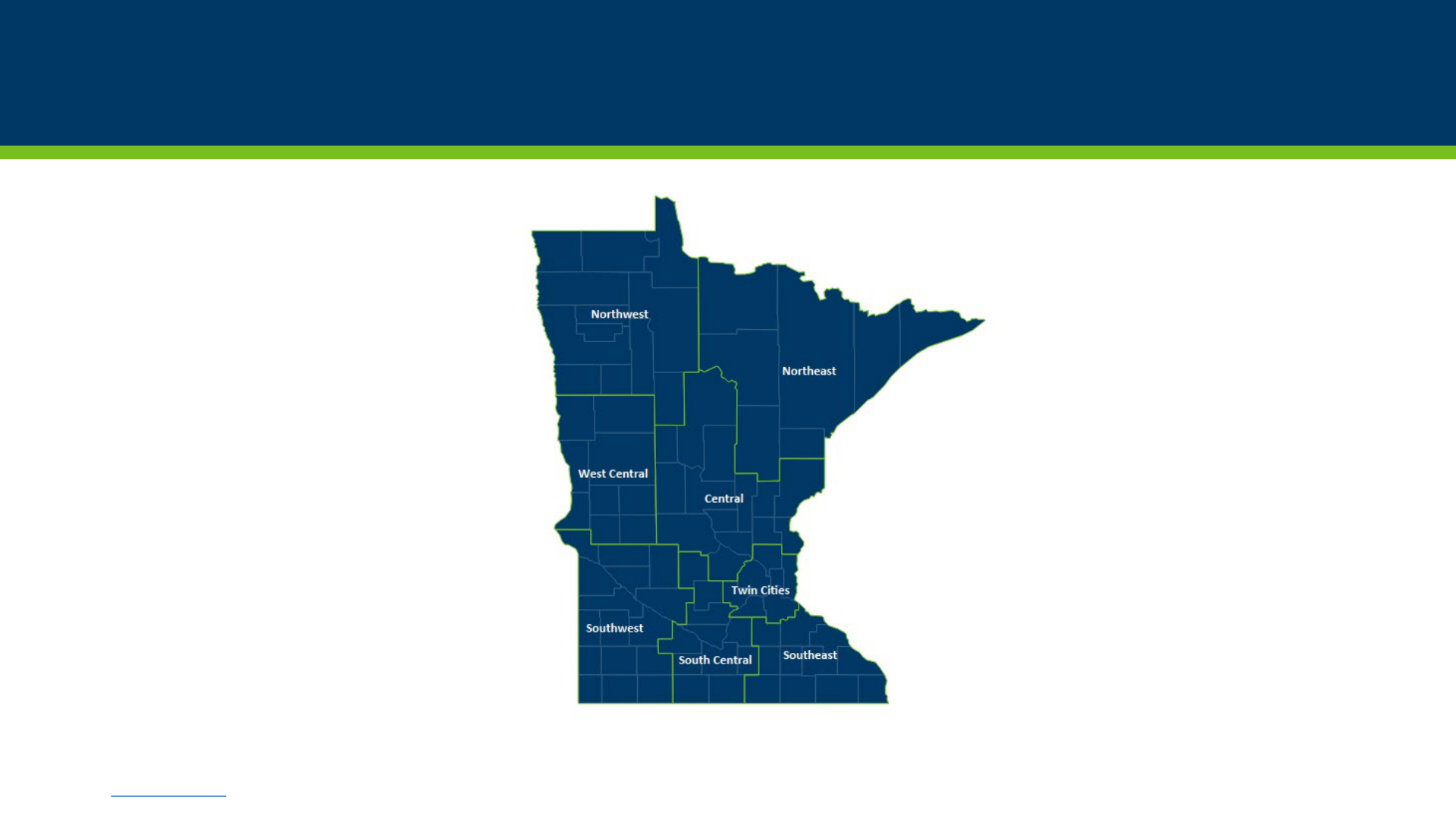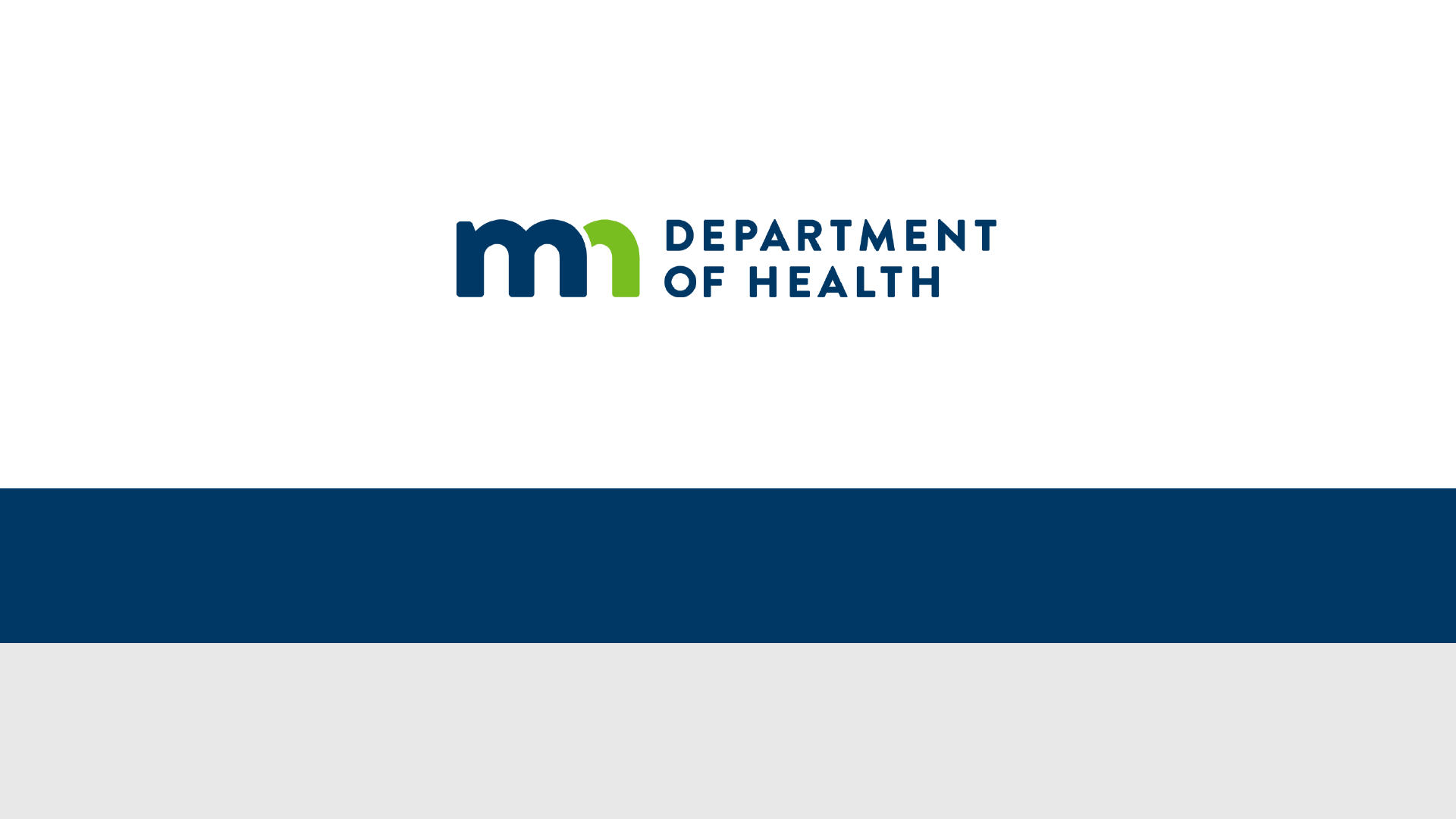
Chartbook Section 7:
Health Plan Companies

Section 7: Health Plan Companies
• Private health plan company market shares
• HMO financial statistics
• Net income & margins
• Reserves
• HMO enrollment statistics
2
This slide deck is part Minnesota’s Health Care Markets Chartbook, an annual review of key metrics in health care access, coverage, market competition and health care
costs (MN Statutes, Section 144.70; https://www.revisor.mn.gov/statutes/cite/144.70)
A summary of the charts and graphs contained within is provided on the MDH website (http://www.health.state.mn.us/data/economics/chartbook/summaries/
section7summaries.html). Direct links are listed on each page. Please contact the Health Economics Program at 651-201-4520 or [email protected] if additional
assistance is needed for accessing this information.
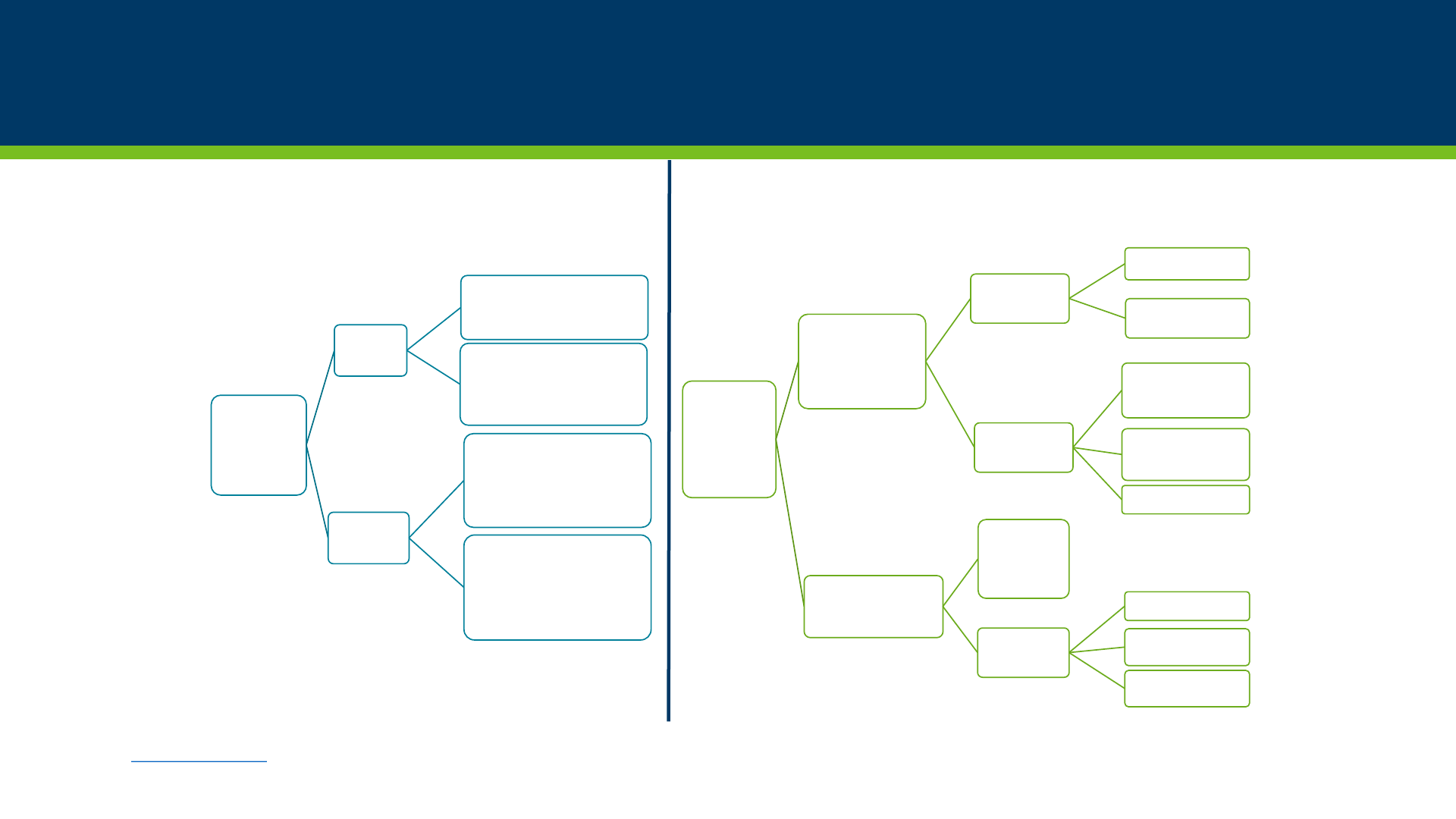
Ways to Describe Health Plan Companies
and Coverage Types
3
Health
Plan
Company
Private
(Commercial)
Coverage
Self Insured
Claims Processing
Network Rental
Fully Insured
Large Group (50+
employees)
Small Group (2-50
employees)
Individual Market
Public
Coverage
State Public
Programs
(HMO Only)
Medicare
Medicare Cost
Medicare
Advantage
Medicare Part D
Health
Plan
Company
For
Profit
HMO
(e.g., UnitedHealthcare of
Illinois, Inc. )
Insurance Company
(e.g., HealthPartners
Insurance Company, Medica
Insurance Company)
Non-
Profit
HMO
(e.g., Blue Plus,
HealthPartners, Inc., Medica
Health Plans, UCare
Minnesota)
Health Service Plan
Corporation
(e.g., Blue Cross Blue Shield
of Minnesota)
Health Plan Company
Organization
Types of Coverage Offered
Figures are for illustration purposes only and do not include all health plan companies and all types of public and private
coverage. Summary of Diagrams

Key Terms
Listed in the order they are used in the chartbook
• Fully-insured plan – Employer health insurance coverage where the health insurance company takes on the risk of medical bills for employees and their dependents (employer purchases plan from
insurance company).
• Health Maintenance Organizations (HMO) – corporations which provide comprehensive health insurance coverage to Minnesotans. They also provide health care to state public programs enrollees
through contracts with the Minnesota Department of Human Services and to Medicare beneficiaries through contracts with the Center for Medicare and Medicaid Services. HMOs are licensed pursuant
to Minnesota Statutes, chapter 62D and Minnesota Rules, part 4685.
• Market share – the allocation of revenues by source of coverage, health plan company market share, HMO status, and non-profit status. Data is based on the fully insured private (commercial) market.
• Net income – The amount of money a business has after all expenses (including non-operating expenses) have been paid; this can also be used as an indicator of a business’ profitability.
• Operating income – The amount of money a business has after all operating expenses have been paid.
• Premiums – the amount paid for health insurance each month.
• Product Lines – these are the different types of health insurance provided by public programs.
• PMAP – Prepaid Medical Assistance Program
• MSC+ – Minnesota Senior Care Plus. MSC+ data prior to 2017 was not consistently broken out by health plan companies prior to 2017 and is included in the MSC+ category, as able.
• MSHO – Minnesota Senior Health Options
• SNBC – Special Needs Basic Care
• Medicare – Medicare Choice, Medicare Cost, and Medicare Advantage plans
• All Other – Medicare Part D (standalone), Medicare Supplement and Select products. Net income and profitability also include Dental product financial reporting.
• Total Revenue – the amount of money a business makes from all products and services the business sells, prior to any expenses.
4
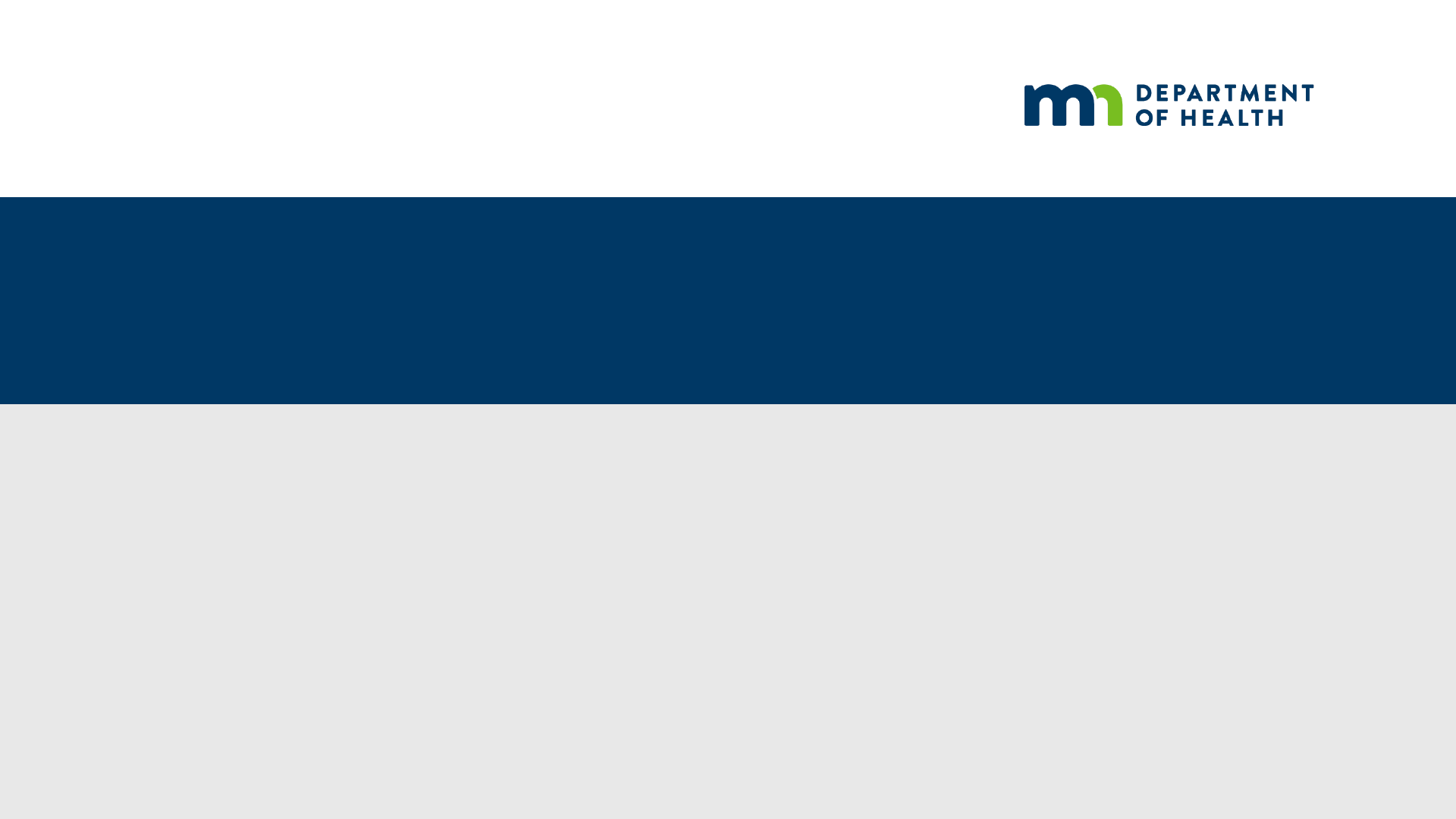
Health Plan Companies: Market Share
(includes HMO and non-HMO health plan companies)
Information contained in this section illustrates the allocation of revenues by
source of coverage, health plan company market share, HMO status, and non-profit
status. Data is based on the fully insured private (commercial) market.
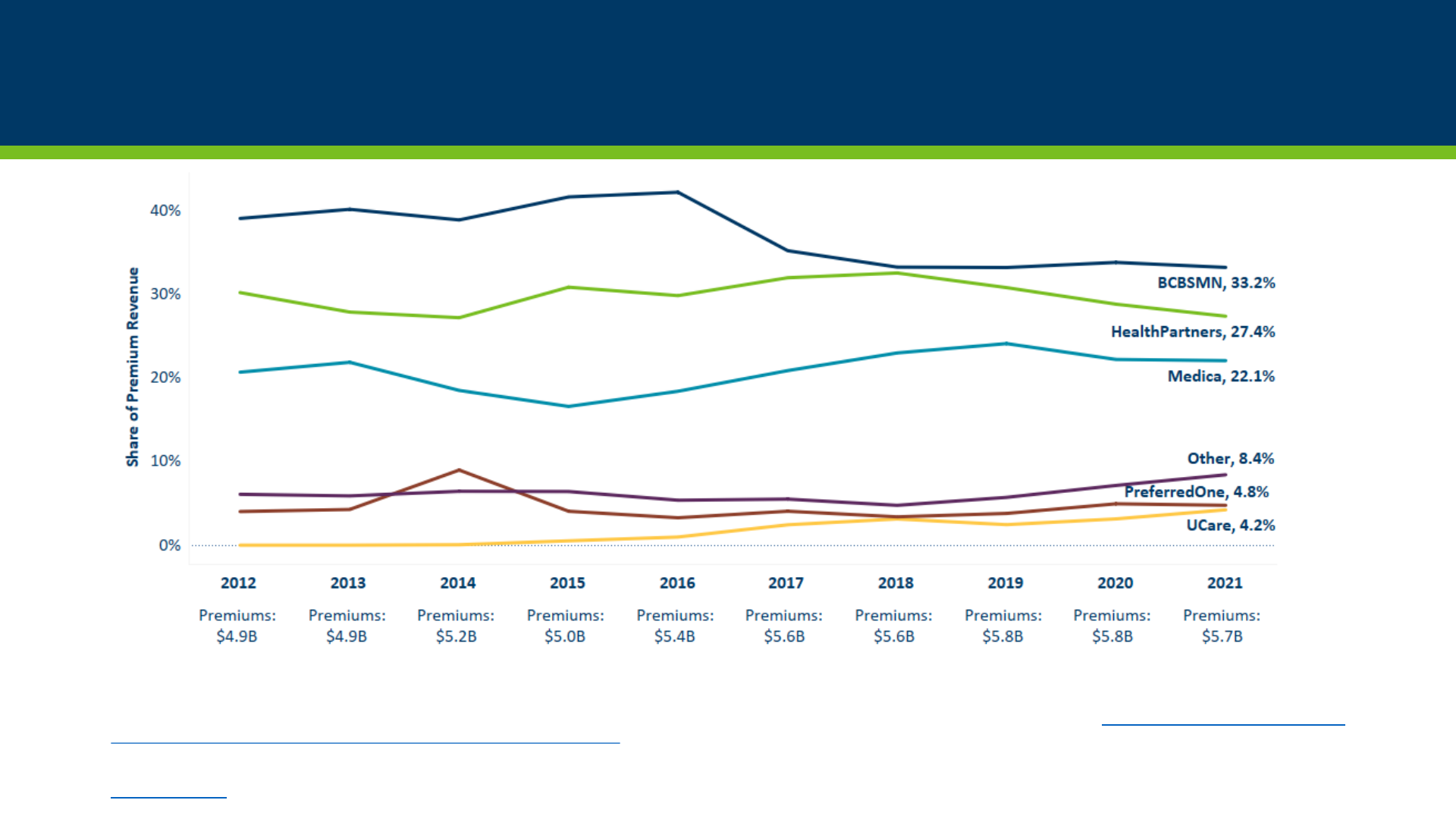
Health Plan Company Market Shares:
Fully Insured Private Market
6
Companies with common ownership were treated as one entity. For example, BCBSMN includes Blue Cross Blue Shield of MN and Blue Plus. Fully insured private (commercial) market only, market
share based on medical premium volume only; it does not include dental premium volume. Market shares for small group and individual markets are available in
Health Care Markets Chartbook Section
4 (
https://www.health.state.mn.us/data/economics/chartbook/docs/section4.pdf). UCare entered the private market in 2014.
Source: MDH Health Economics Program, analysis of Health Plan Financial and Statistical Reports which covers health plan companies with over $3 million in annual premium revenue, as well as non-
profit health plan companies. Data as of March 8, 2023.
Summary of Graph
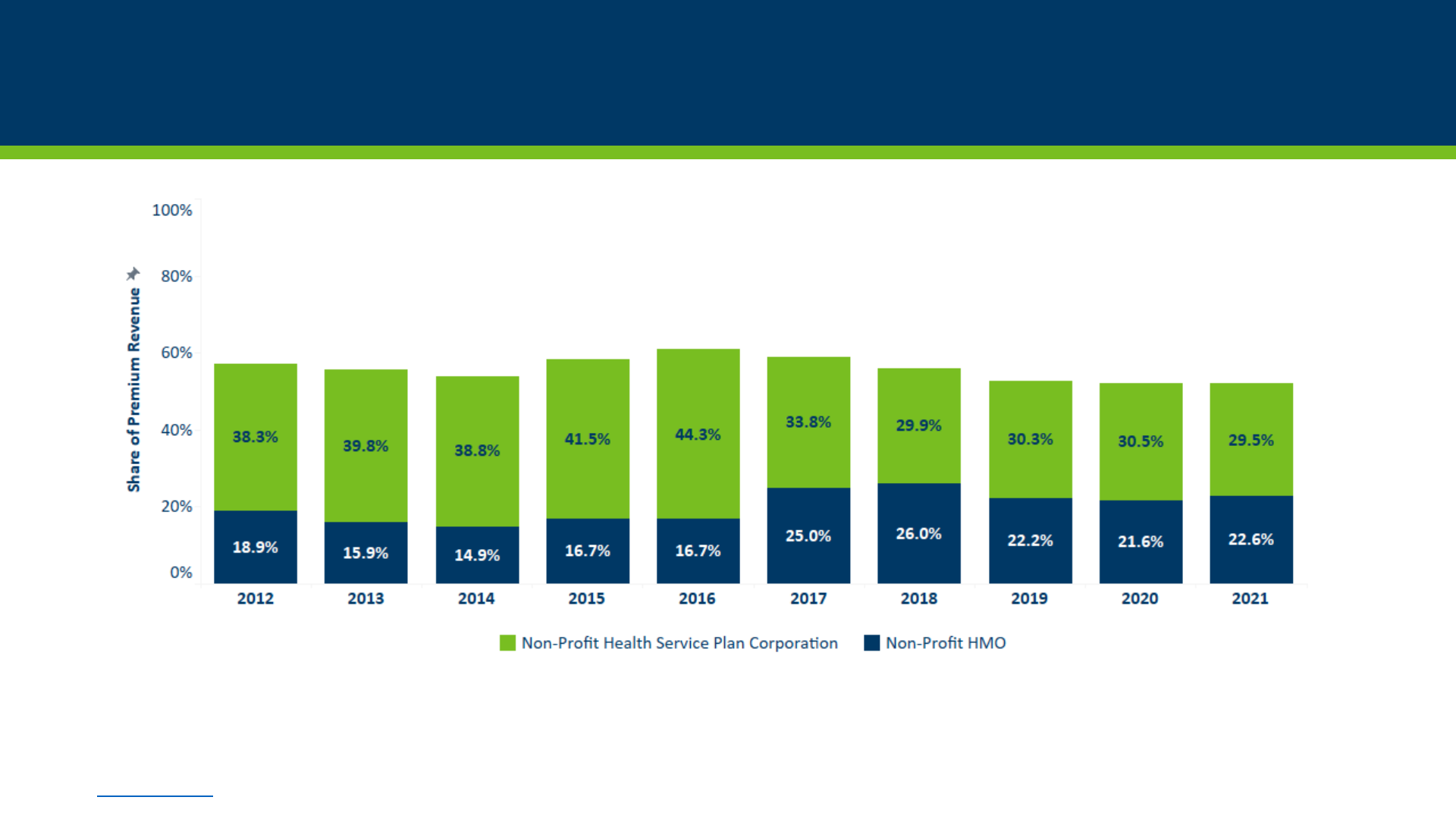
Market Share of Minnesota Non-Profit Health Plan
Companies and HMOs: Fully Insured Private Market
7
Fully insured private (commercial) market only, market share based on medical premium volume only; it does not include dental premium volume. Non-profit health plan companies include both non-
profit HMOs and non-profit health service plan companies, which pay a 1.0% premium tax. HMOs are licensed pursuant to Minnesota Statutes, chapter 62D and Minnesota Rules, part 4685.
Source: MDH Health Economics Program, analysis of Health Plan Financial and Statistical Reports which covers health plan companies with over $3 million in annual premium revenue, as well as non-
profit health plan companies. Data as of March 8, 2023.
Summary of Graph
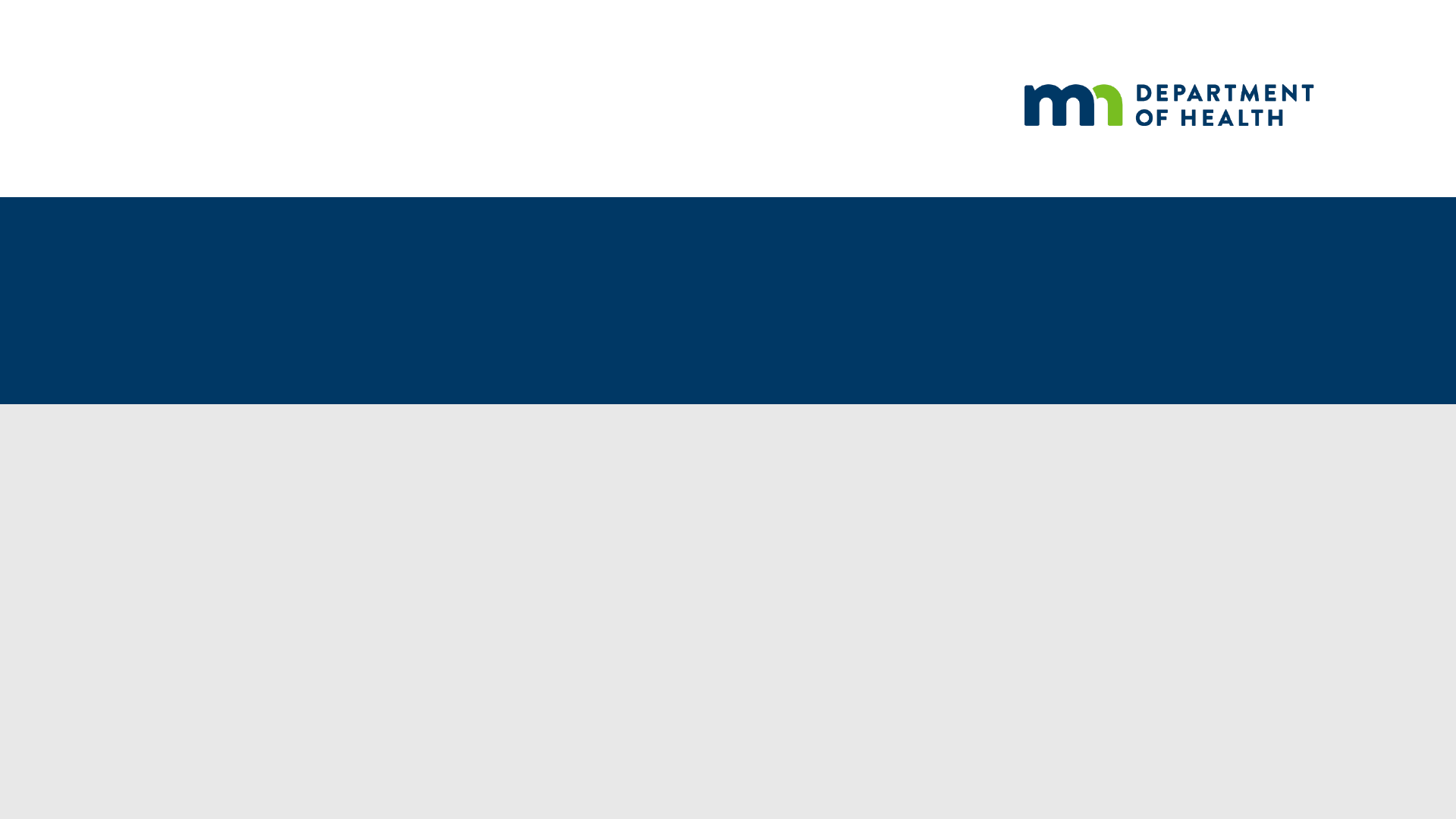
HMO Financial Statistics
Health Maintenance Organizations (HMO) are corporations which provide comprehensive health insurance coverage
to Minnesotans. HMOs deliver services for a majority of state public programs enrollees through contracts with the
Minnesota Department of Human Services, and to Medicare beneficiaries through contracts with the Center for
Medicare and Medicaid Services (CMS). Comprehensive financial reporting, summarized in this section and collected
pursuant to Minnesota Statutes, chapter 62D and Minnesota Rules, part 4685, provides transparency for state
policymakers, regulators and consumers.
Unless stated, information presented in this section does not include County Based Purchasers (CBPs) established
under Minnesota Statutes, chapter 256B.292 and data is based on fully insured HMOs. Data includes all product lines
unless otherwise noted.
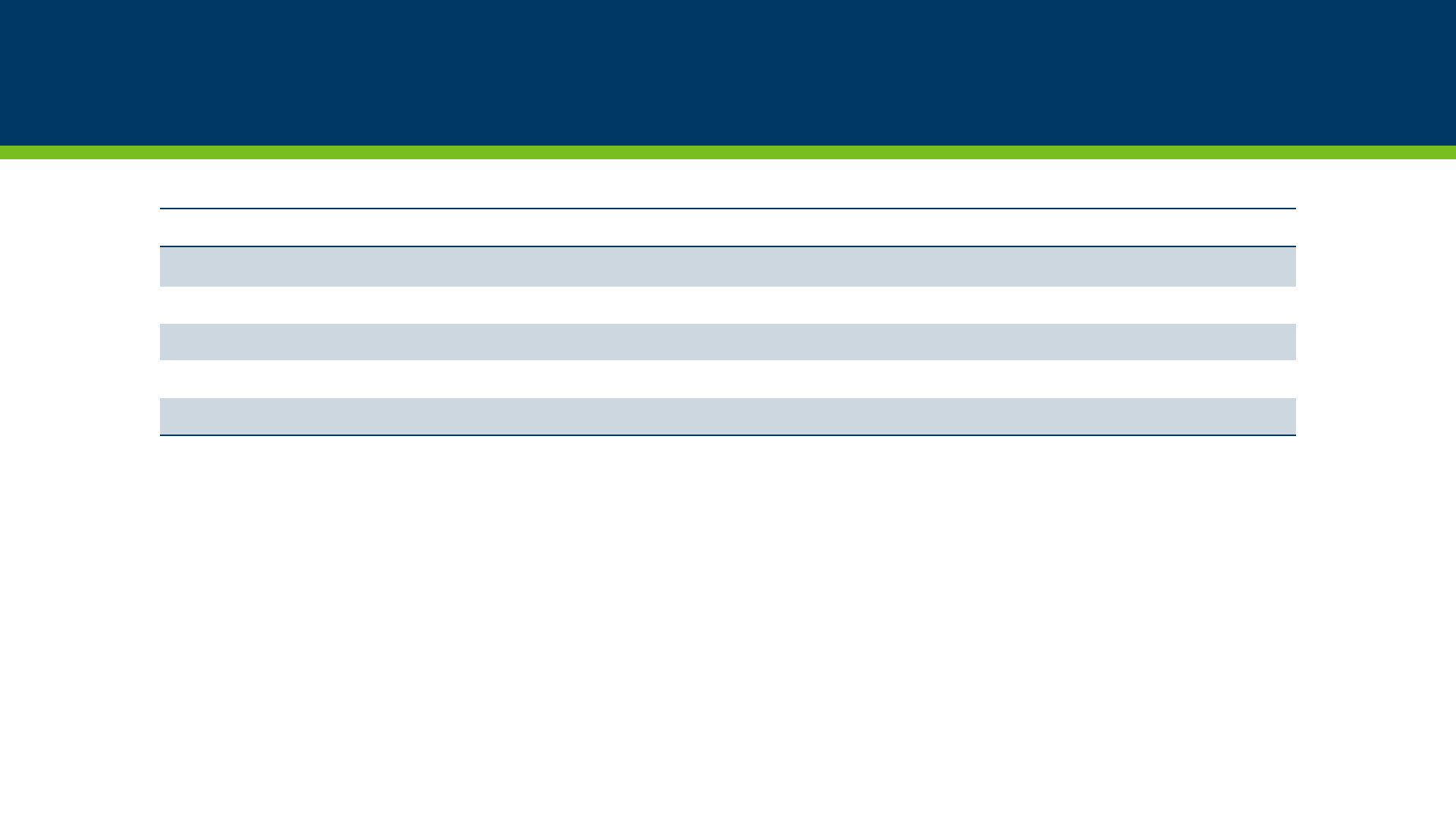
Summary of HMO Financial Trends, Total Business
9
2018 2019 2020 2021 2022
Net Income ($ in millions)
$260.7M ($64.1M) $291.0M $259.3M $668.8M
Total Revenue ($ in millions)
$10,337.8M $10,645.3M $11,375.9M $13,235.3M $15,215.4M
Operating Income as % of Revenue
1.7% -1.6% 1.8% 0.8% 4.1%
Net Income as % of Revenue
2.5% -0.6% 2.6% 2.0% 4.4%
Net Income per Member Month $16.78 ($3.88) $17.77 $14.16 $34.59
Minnesota products only. Excludes Administrative Services, Foundation, and Business Development Net Income and Revenue. Calculations for operating income and net income as % of revenue
are not rounded.
Source: MDH Health Economics Program analysis of Minnesota Supplement #1 HMO report.
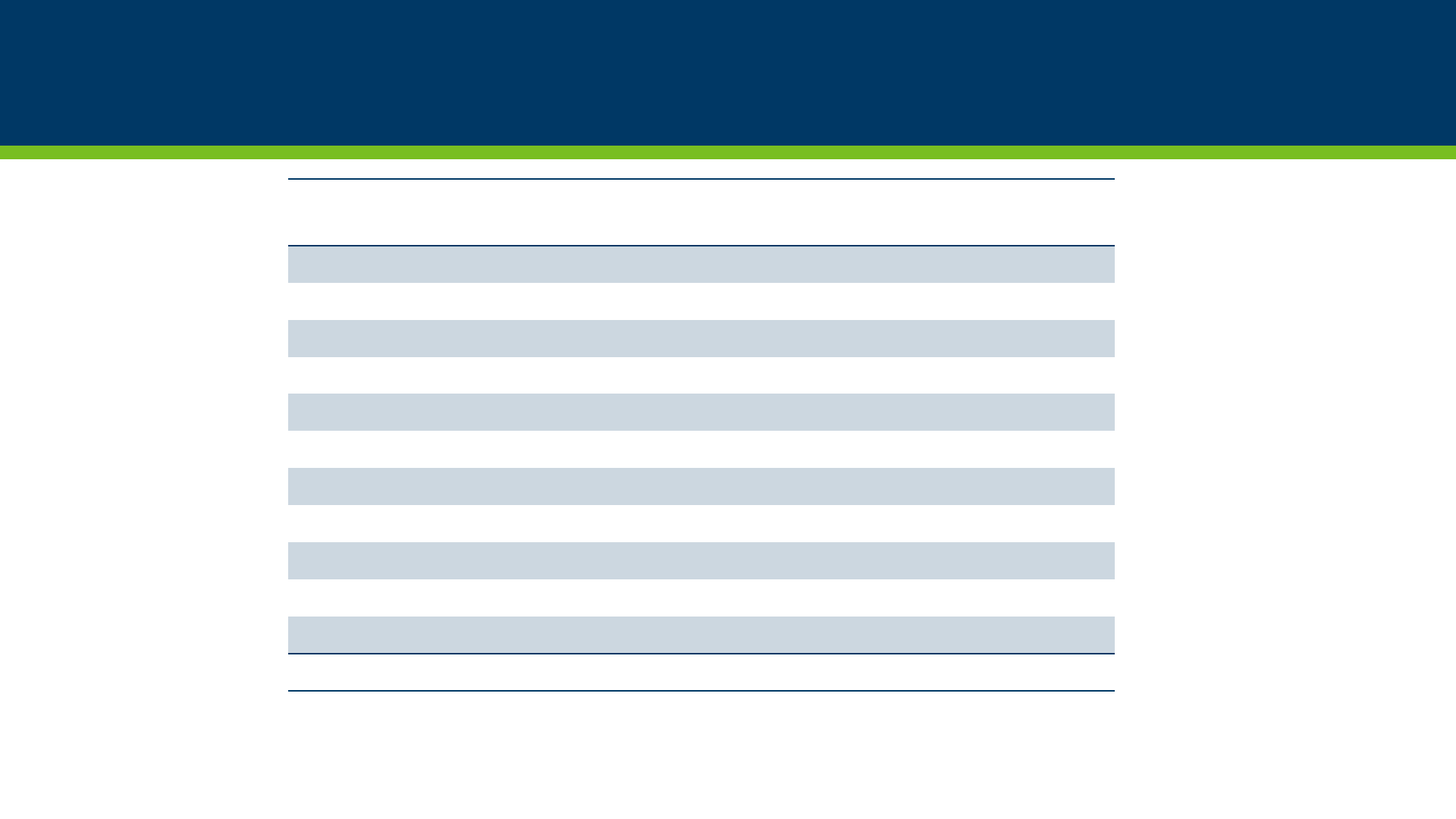
Net Income and Profitability by HMO, 2022
10
Net Income
($ in millions)
Total Revenue
($ in millions)
Net Income as %
of Revenue
Blue Plus
$177.8M $2,978.0M 6.0%
Group Health
($92.8M) $1,200.6M -7.7%
HealthPartners, Inc.
$150.0M $2,932.0M 5.1%
Hennepin Health
$17.8M $444.3M 4.0%
Humana Wisconsin
($1.7M) $32.8M -5.2%
Medica Community Health Plans
($0.5M) ($0.2M) 209.9%
Medica Health Plans
$72.5M $1,300.5M 5.6%
Quartz
$0.0M $38.8M 0.1%
Sanford
($4.2M) $16.3M -25.6%
UCare
$327.7M $6,075.5M 5.4%
UnitedHealthcare of Illinois
$22.2M $196.7M 11.3%
All HMOs $668.8M $15,215.4M 4.4%
Minnesota products only. Excludes Administrative Services, Foundation, and Business Development Net Income and Revenue. Health plan companies are ordered alphabetically. Medica
Community Health Plans has no membership. Calculations for net income as % of revenue are not rounded.
Source: MDH Health Economics Program analysis of Minnesota Supplement #1 HMO report.
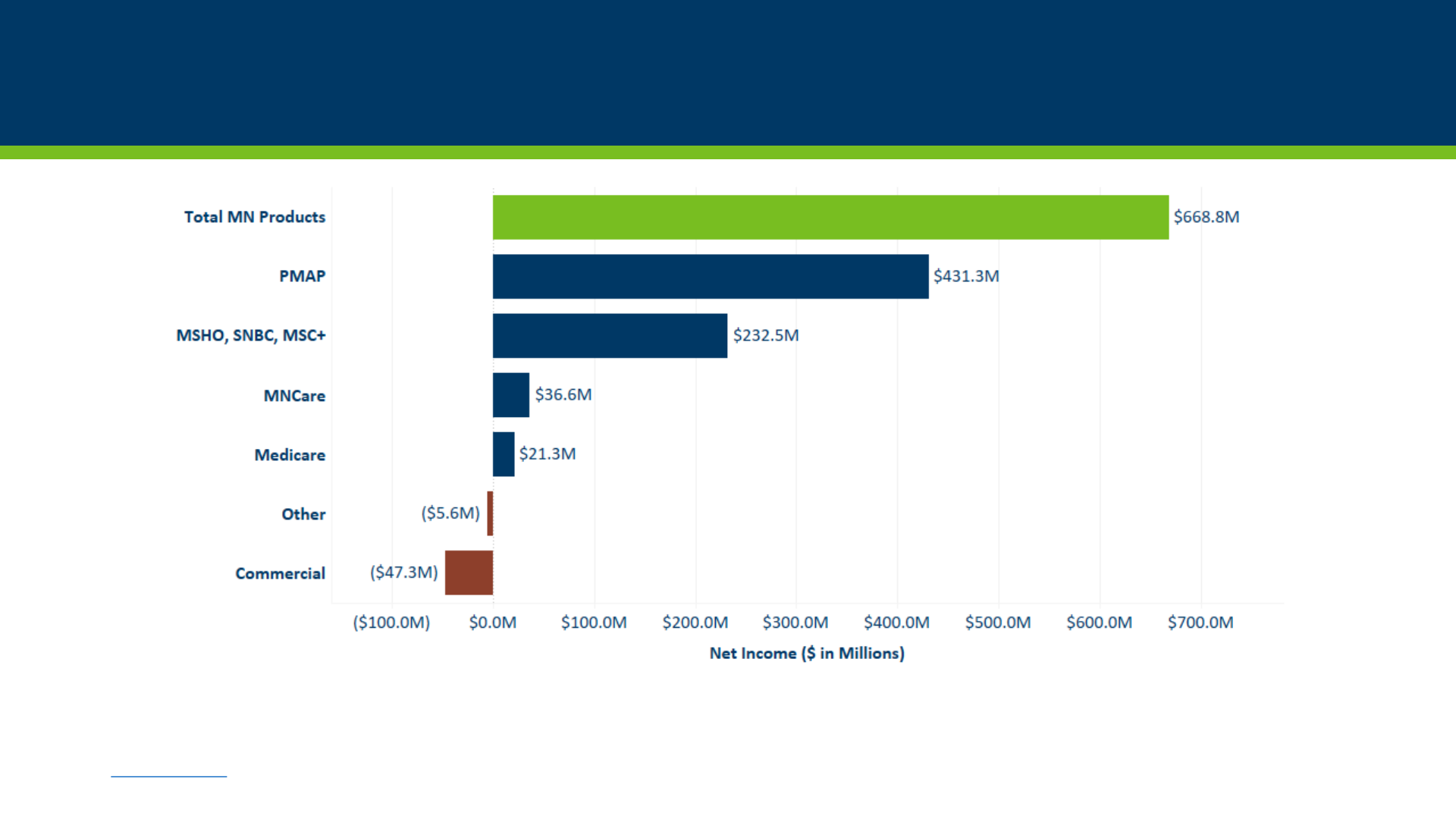
Minnesota HMO Net Income by Product Line, 2022
11
Minnesota products only. Excludes Administrative Services, Foundation, and Business Development Net Income and Revenue. The total includes “other” coverage (standalone Medicare Part D,
Medicare Supplement, Medicare Select, Risk Corridor, and Dental). Key terms are included on slide 4. Product lines are in order of net income. Product lines are in order of net income.
Source: MDH Health Economics Program analysis of Minnesota Supplement #1 HMO report.
Summary of Graph
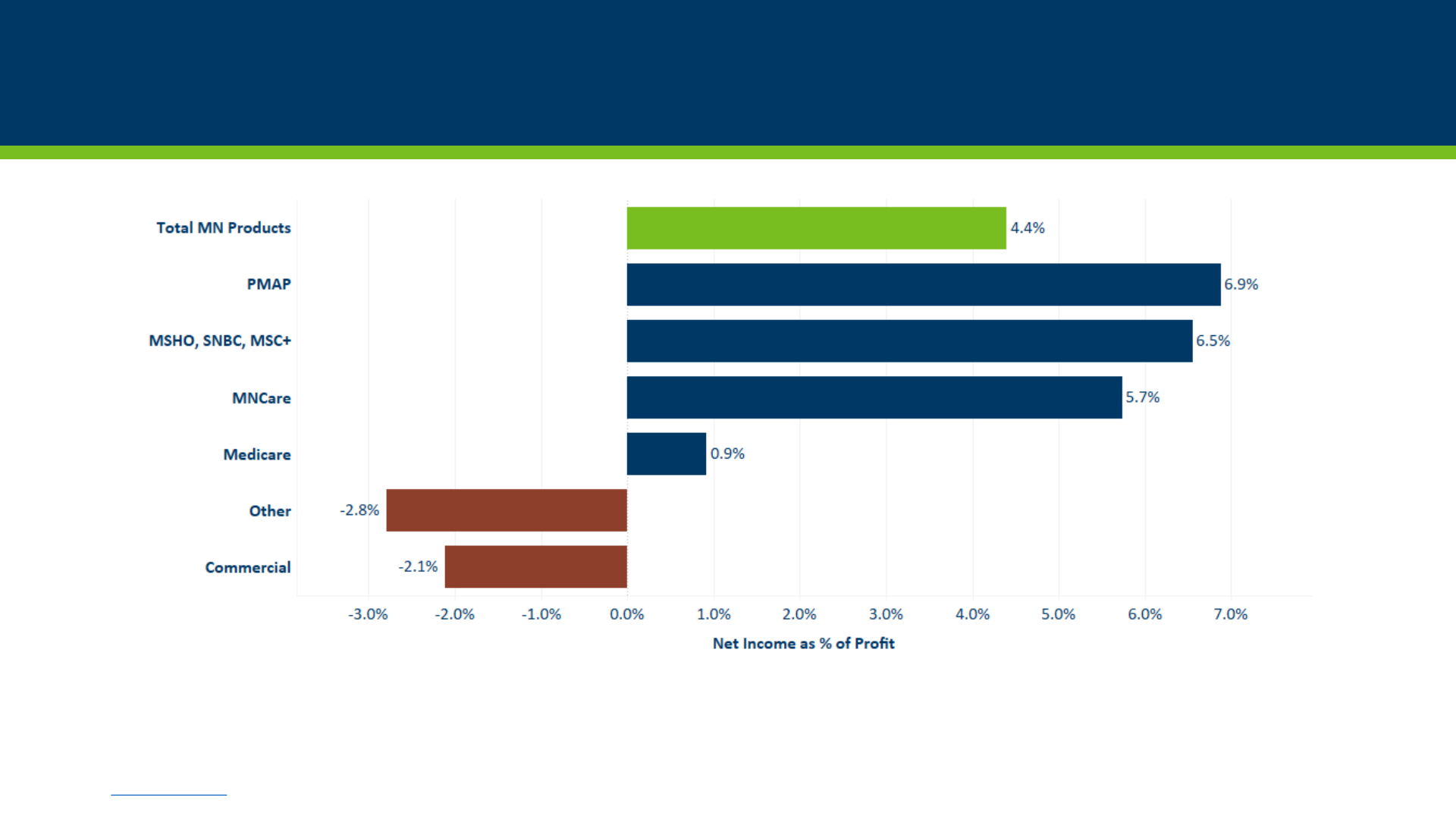
Minnesota HMO Profitability by Product Line, 2022
12
Minnesota products only. Excludes Administrative Services, Foundation, and Business Development Net Income and Revenue. The total includes “other” coverage (standalone Medicare Part D, Medicare
Supplement, Medicare Select, Risk Corridor, and Dental). Key terms are included on slide 4. Product lines are in order of net income.
Source: MDH Health Economics Program analysis of Minnesota Supplement #1 HMO report.
Summary of Graph
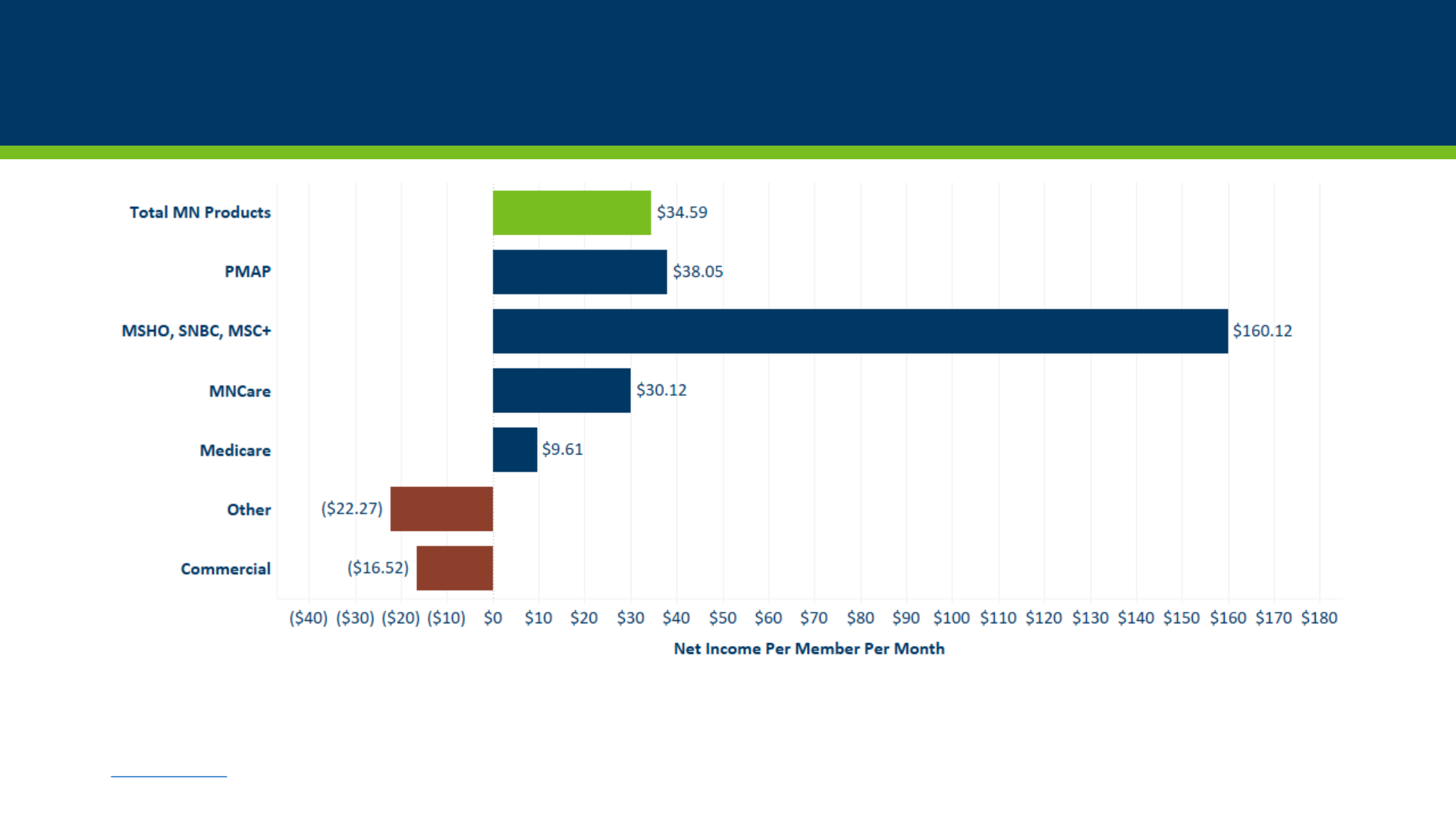
Minnesota HMO Net Income per Member Month by
Product Line, 2022
13
Minnesota products only. Excludes Administrative Services, Foundation, and Business Development Net Income and Revenue. The total includes “other” coverage (standalone Medicare Part D,
Medicare Supplement, Medicare Select, Risk Corridor, and Dental). Key terms are included on slide 4. Product lines are in order of net income.
Source: MDH Health Economics Program analysis of Minnesota Supplement #1 HMO report.
Summary of Graph

Sources of HMO Net Income
14
2018 2019 2020 2021 2022
Sources of Net Income ($ in millions):
Net underwriting gain/loss
$180.1M ($167.3M) $208.4M $107.6M $617.5M
Investment Income
$81.5M $83.5M $59.3M $73.9M $82.0M
Other
($0.9M) $19.6M $23.3M $77.8M ($30.7M)
Net Income
$260.7M ($64.1M) $291.0M $259.3M $668.8M
Investment income as % of net income
1
31.3% 20.4% 28.5% 12.3%
1
Investment income as a percent of net income is not listed when HMOs have a negative net income and a positive investment income. Minnesota products only. Excludes Administrative Services,
Foundation, and Business Development Net Income (all sources and investments). Calculations for investment income as % of revenue are not rounded.
Source: MDH Health Economics Program analysis of Minnesota Supplement #1 HMO report.
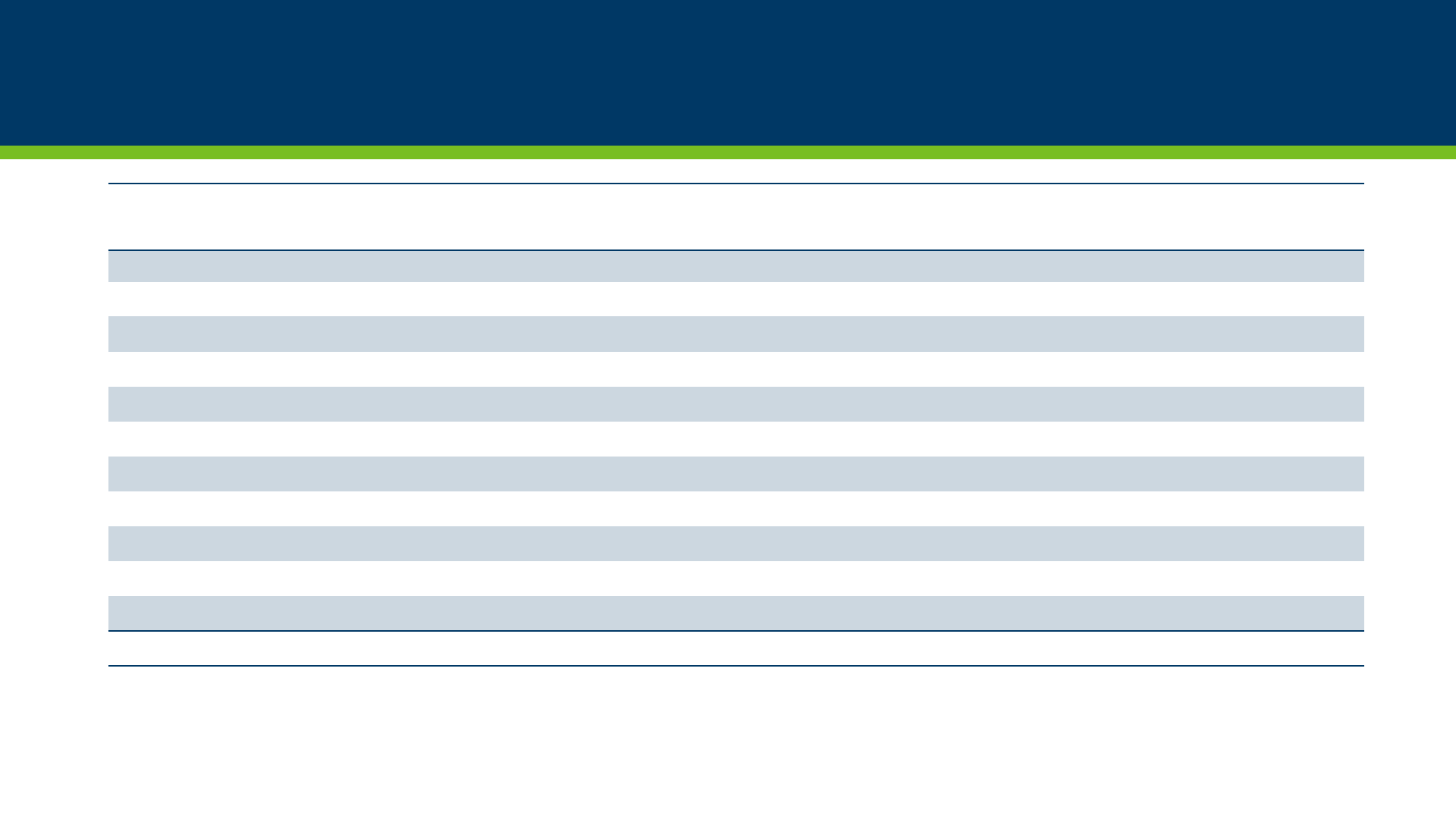
Investment Income as a Percent of Net Income
by HMO, 2022
15
1
Investment income as a percent of net income is not listed for HMOs that have a negative net income and a positive investment income.
Minnesota products only. Excludes Administrative Services, Foundation, and Business Development Net Income (all sources and investments). Calculations for investment income as % of revenue are
not rounded.
Source: MDH Health Economics Program analysis of Minnesota Supplement #1 HMO report.
Investment Income
($ in millions)
Net Income
($ in millions)
Investment Income as % of
Net Income
1
Blue Plus
$28.6M $177.8M 16.1%
Group Health
$7.6M ($92.8M)
HealthPartners, Inc.
$7.7M $150.0M 5.1%
Hennepin Health
($5.6M) $17.8M
Humana Wisconsin
$0.0M ($1.7M)
Medica Community Health Plans
$0.0M ($0.5M) 0.0%
Medica Health Plans
$15.5M $72.5M 21.3%
Quartz
$0.1M $0.0M 320.9%
Sanford
$0.0M ($4.2M)
UCare
$27.0M $327.7M 8.2%
UnitedHealthcare of Illinois
$1.1M $22.2M 5.0%
All HMOs $82.0M $668.8M 12.3%
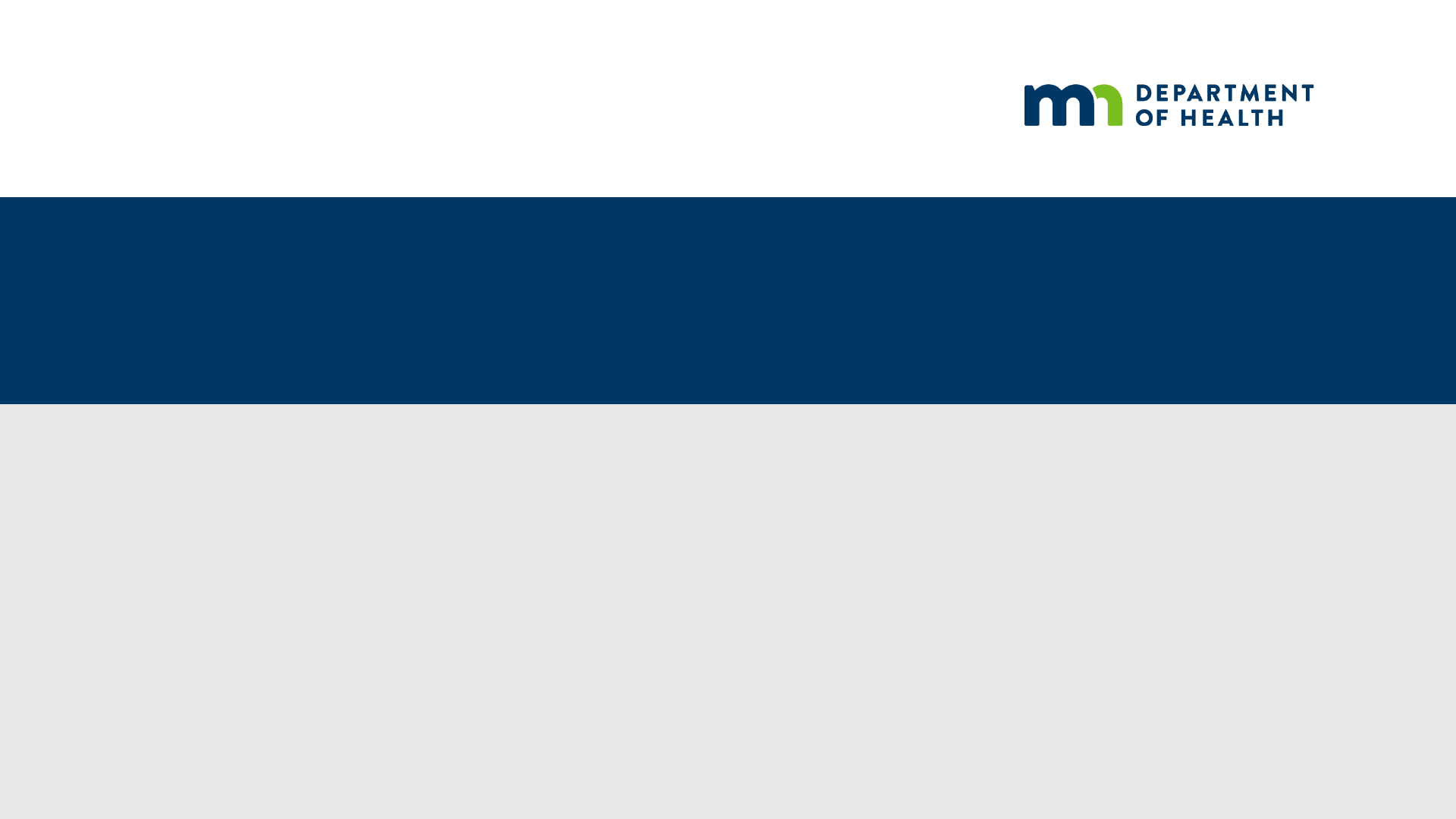
Reserves
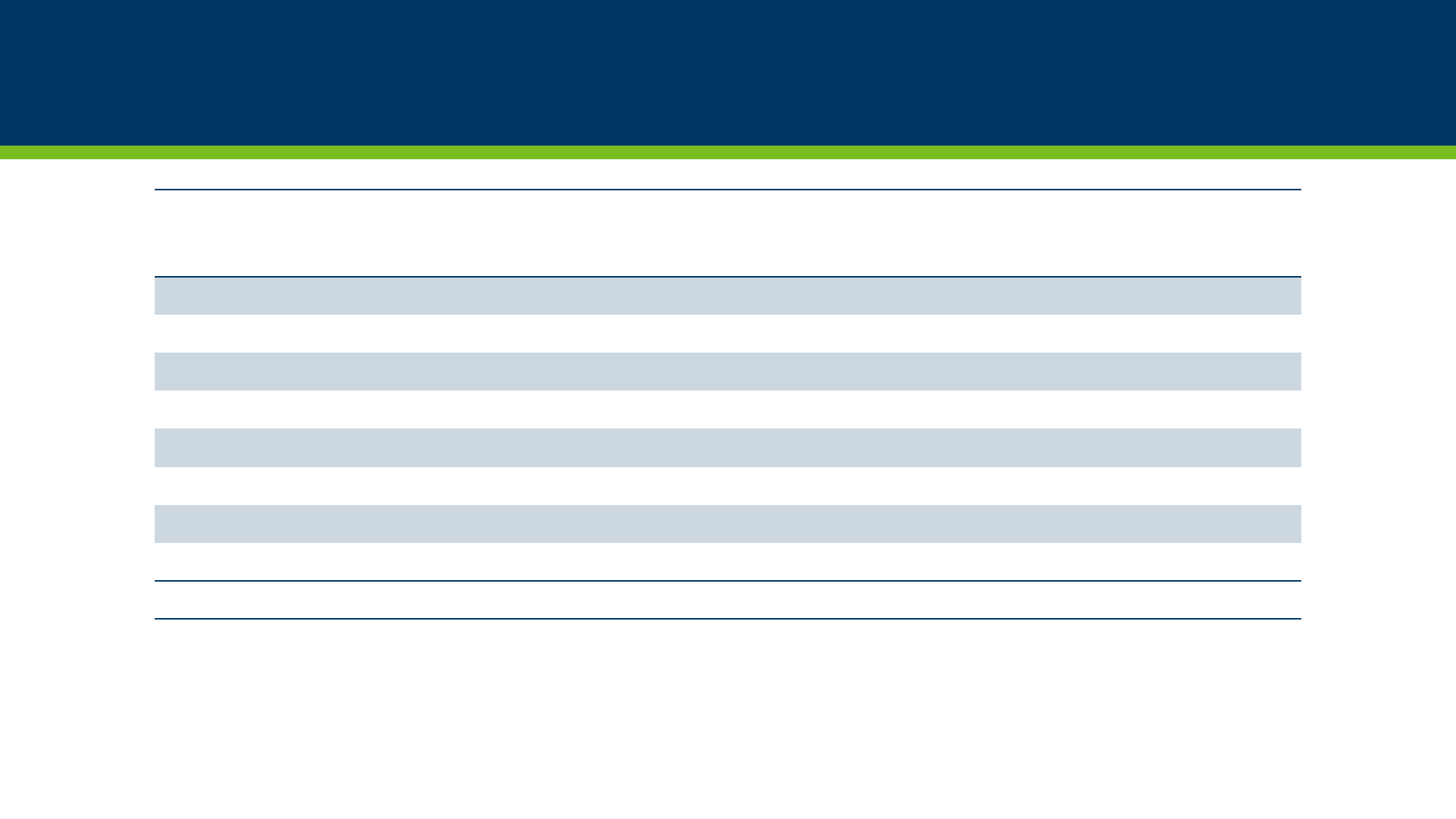
Reserves, Medical Expenses, and Regulatory
Minimum Level by HMO, 2022
1-3
17
1
When applicable, fee-for-service revenue earned was subtracted from expenses to approximate member only expenses for these health plan companies.
2
Reserve minimums are based financial solvency of entire organization; therefore, the calculation includes non-Minnesota business.
3
Company Action Level is defined at 200%. For more information, see Minnesota Statutes Chapter 60A.50.
Health plan companies are ordered alphabetically. Percentage calculations are not rounded.
Source: MDH Health Economics Program analysis of data from National Association of Insurance Commissioners (NAIC). Only health plan companies that are domiciled within Minnesota. PreferredOne
Community Health Plan ceased prior to December 31, 2021 and therefore had no expenses. Medica Community Health Plan reserve data was not available on a Minnesota-specific basis after 2017.
Reserves
($ in millions)
2
Total Expenses
($ in millions)
Reserves as % of
Total Expenses
Ratio Above
Company Action
Level
3
BluePlus
$894.4M $2,475.9M 36.1% 4.5
Group Health¹
$81.4M $417.5M 19.5% 1.2
Hennepin Health
$61.8M $381.8M 16.2% 2.0
HealthPartners, Inc.¹
$1,063.4M $2,594.7M 41.0% 2.8
Medica Health Plans
$617.2M $1,148.5M 53.7% 6.2
Quartz
$5.9M $36.1M 16.4% 2.7
Sanford¹
$4.8M $16.0M 29.8% 2.3
UCare
$1,125.3M $5,228.0M 21.5% 2.7
All HMOs
$3,854.3M $12,298.6M 31.3% 3.2
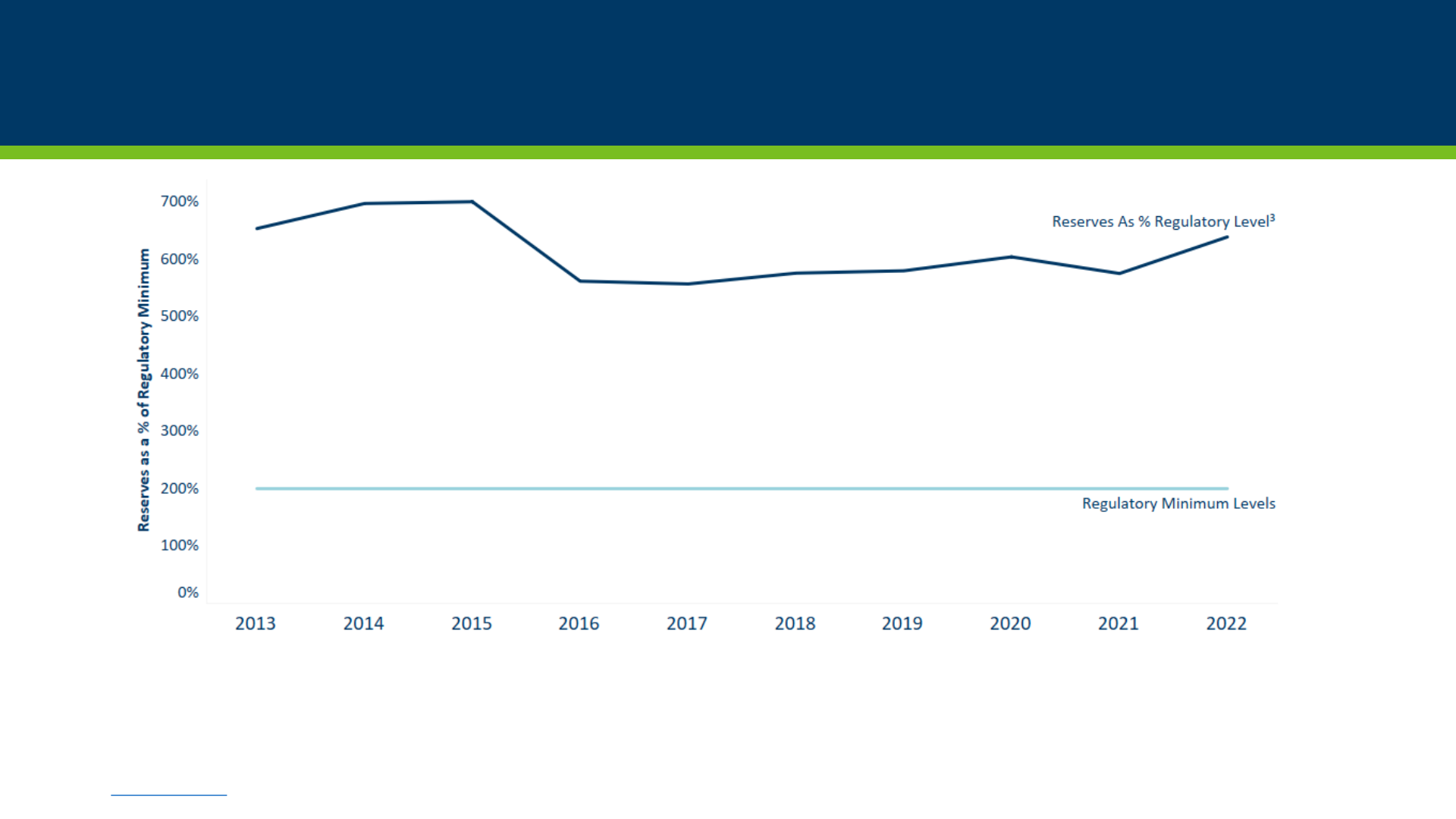
Total Minnesota HMO Reserves Relative to
Regulatory Minimum Levels
1-2
18
1
The Regulatory Minimum Levels are otherwise known as the Company Action Level and is defined at 200%. There are currently no maximum levels. For more information, see Minnesota Statutes
Chapter 60A.50.
2
Reserve minimums are based financial solvency of entire organization; therefore, the calculation includes non-Minnesota business.
3
“Regulatory level” is the authorized control level; total expenses is from line 16 of HMO Minnesota Supplement Report #1 and includes Administrative Services’ Expenses, as applicable.
Source: MDH Health Economics Program analysis of data from National Association of Insurance Commissioners (NAIC). Only health plan companies that are domiciled within Minnesota. PreferredOne
Community Health Plan ceased prior to December 31, 2021 and therefore had no expenses. Medica Community Health Plan reserve data was not available on a Minnesota-specific basis after 2017.
Summary of Graph
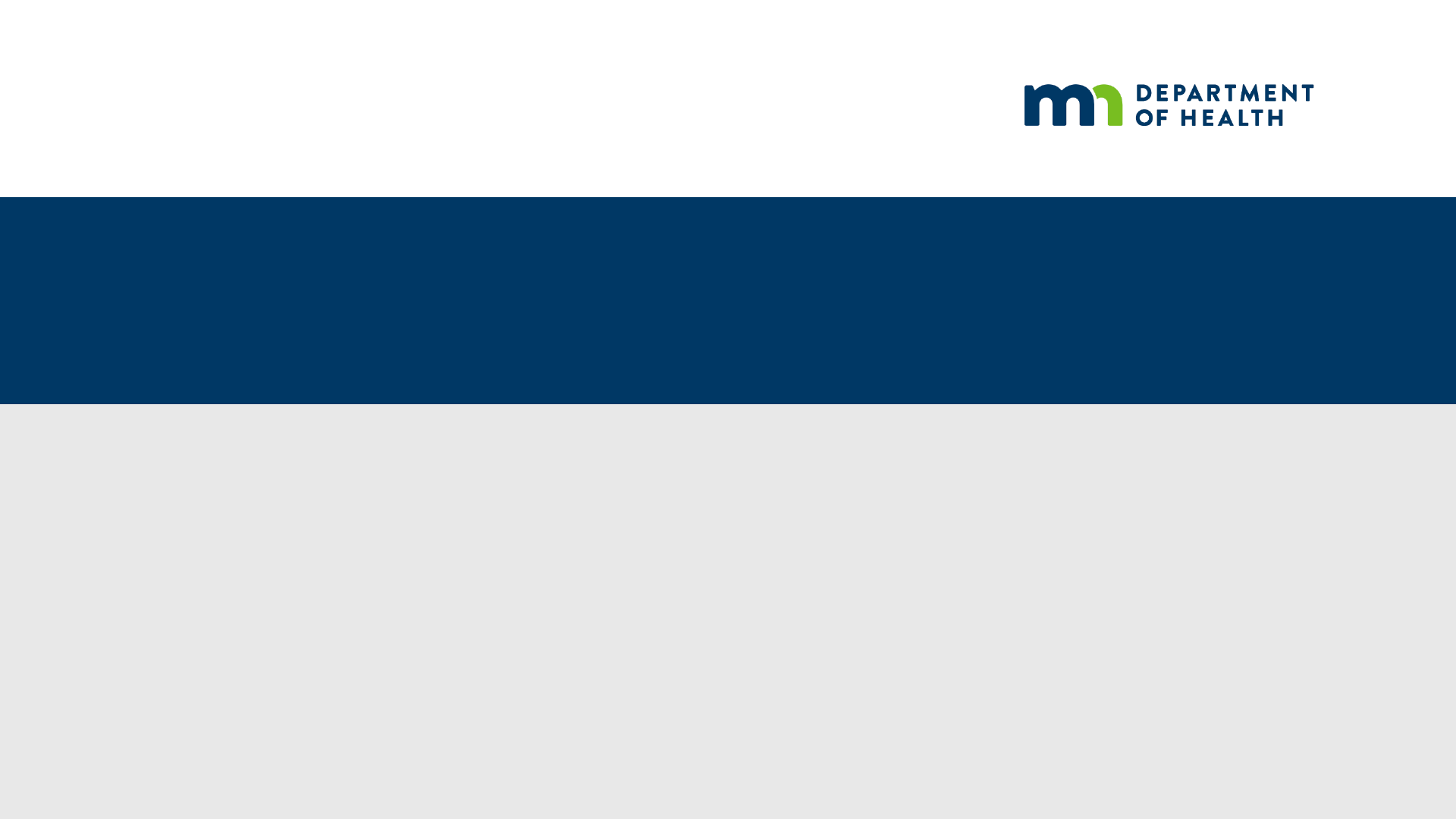
HMO Enrollment
Health Maintenance Organizations (HMO) are corporations which provide comprehensive health
insurance coverage to Minnesotans. They also provide health care to state public programs
enrollees through contracts with the Minnesota Department of Human Services and to Medicare
beneficiaries through contracts with the Center for Medicare and Medicaid Services. HMOs are
licensed pursuant to Minnesota Statutes, chapter 62D and Minnesota Rules, part 4685.
Unless stated, information presented in this section does not include County Based Purchasers (CBPs) established
under Minnesota Statutes, chapter 256B.292 and data is based on fully insured HMOs. Data includes all product
lines unless otherwise noted.
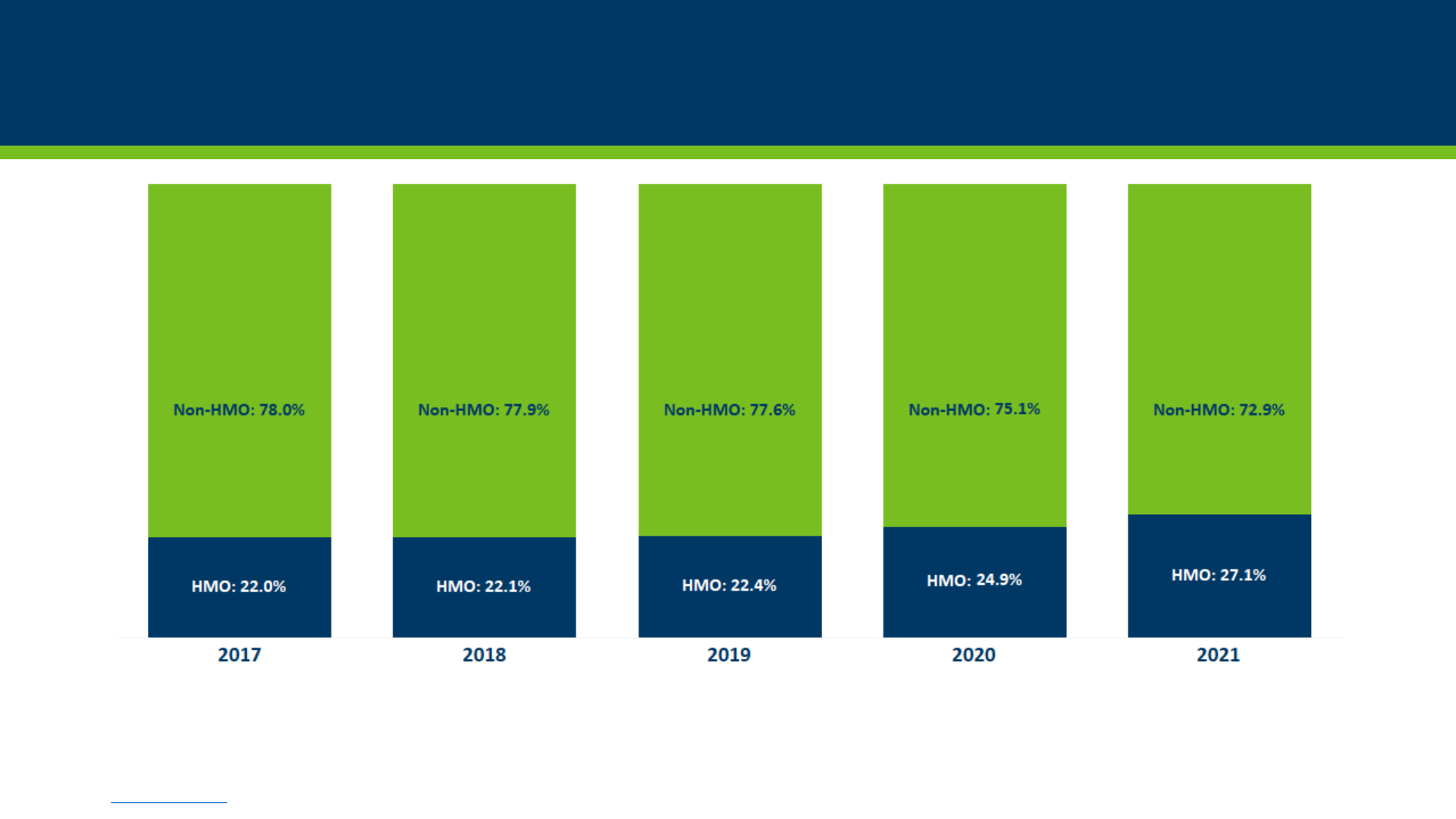
Share of Total Minnesota HMO Enrollment
20
Enrollment figures are as of December 31st of each year for Minnesota residents; excludes residents with an unknown county of residence. Data includes all HMO reported enrollment, even for
program types which may not be primary medical coverage (e.g., standalone Part D, Medicare Supplement, and Medicare Select). As such, HMO enrollment may be overstated.
Source: MDH Health Economics Program analysis of MDH Health Economics Program analysis of Minnesota Supplement #6 HMO report; U.S. Census Bureau, Annual Estimates of the Resident
Population for Counties in Minnesota: April 1, 2020 to July 1, 2021, (CO-EST2021-POP-27).
Summary of Graph
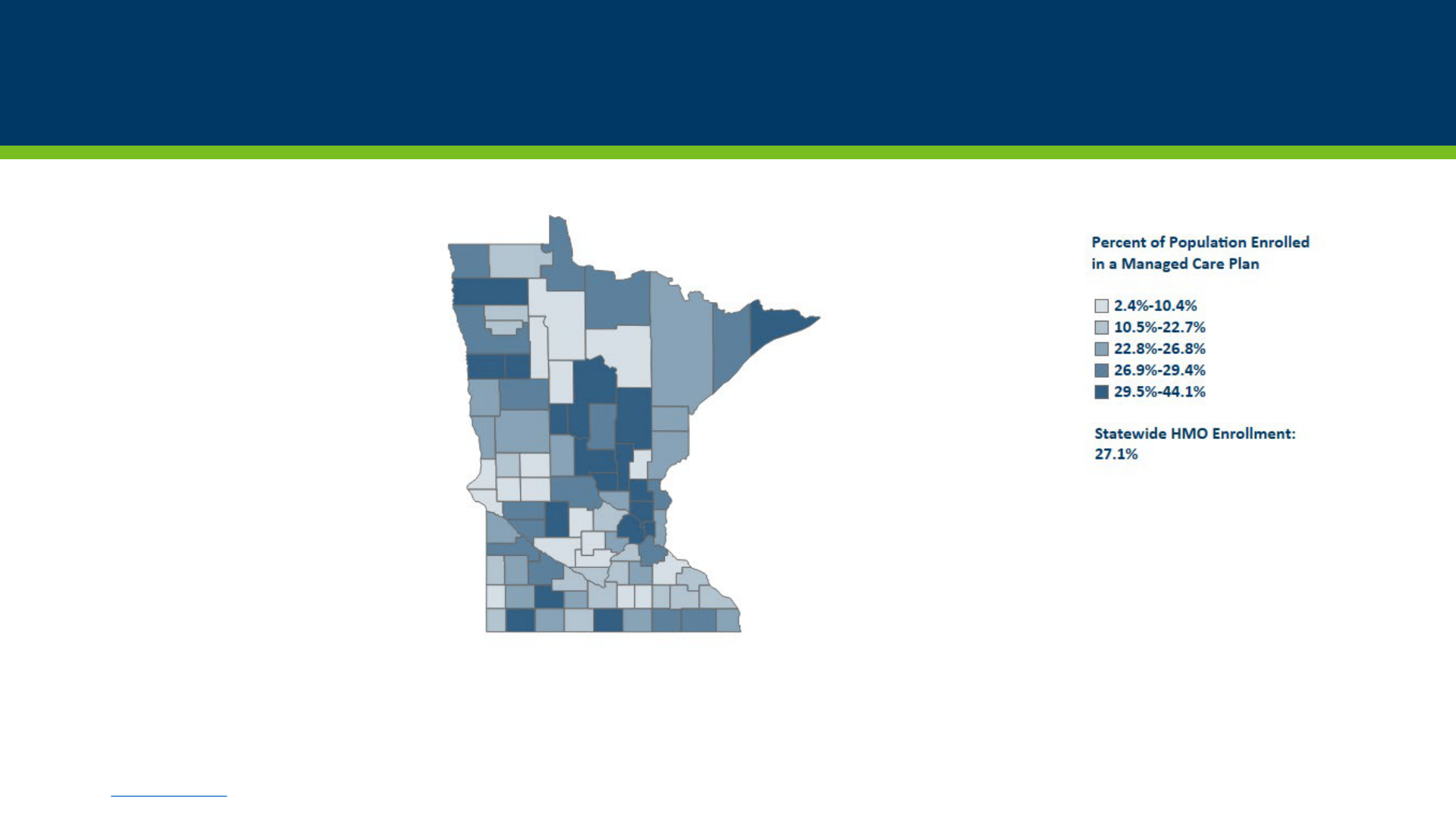
Minnesota’s Percent of Population Enrolled in an HMO,
by County, 2021
21
Enrollment figures are as of December 31st of each year for Minnesota residents; ranges are based on quintiles; excludes residents with an unknown county of residence. Data includes all HMO
reported enrollment, even for program types which may not be primary medical coverage (e.g., standalone Part D, Medicare Supplement, and Medicare Select). As such, HMO enrollment may be
overstated.
Source: MDH Health Economics Program analysis of MDH Health Economics Program analysis of Minnesota Supplement #6 HMO report; U.S. Census Bureau, Annual Estimates of the Resident
Population for Counties in Minnesota: April 1, 2020 to July 1, 2021, (CO-EST2021-POP-27); map shapefile from 2021 Mapbox @OpenStreetMap.
Summary of Graph
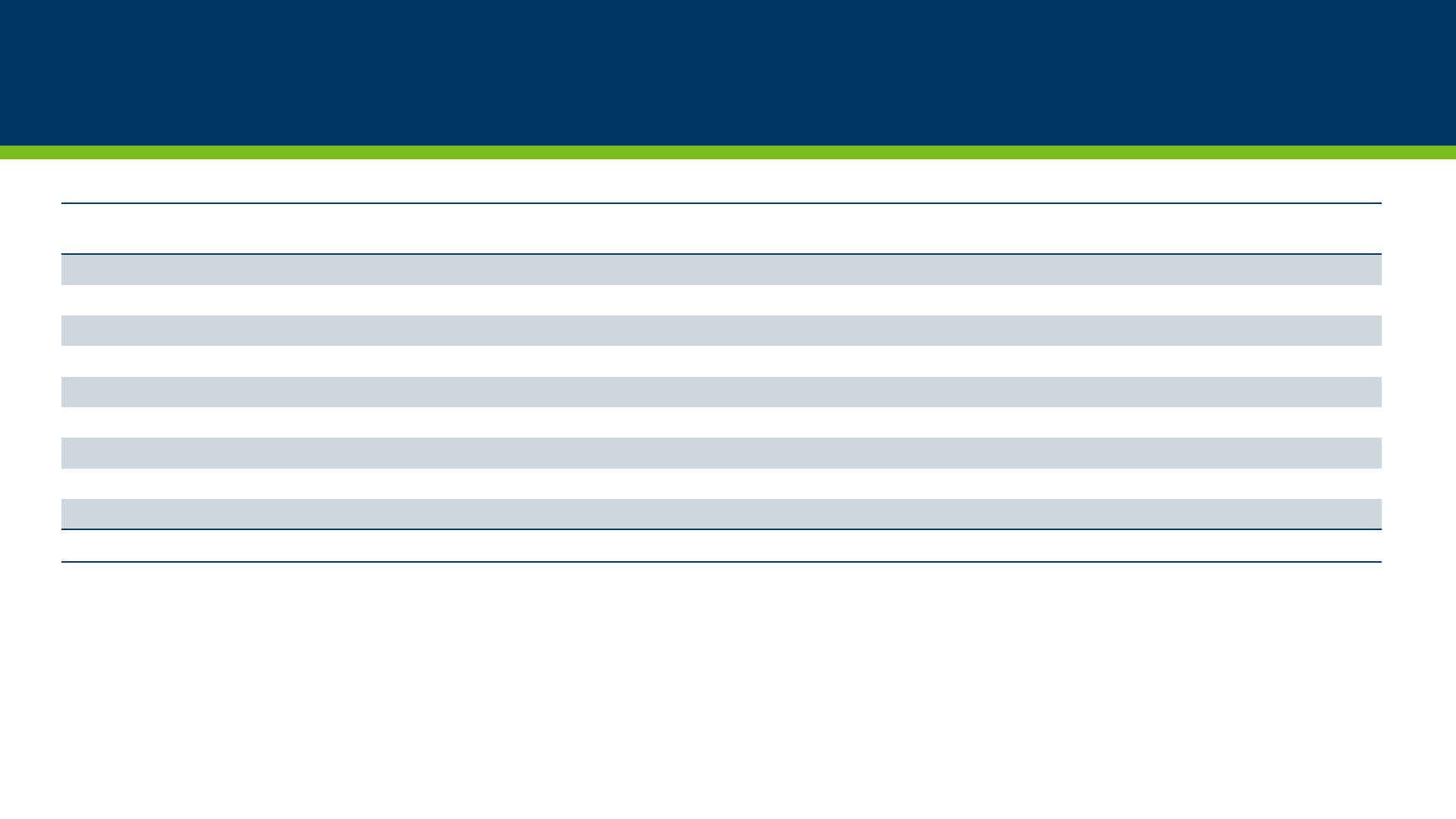
Minnesota HMO Enrollment by Region, 2021
22
Enrollment figures are as of December 31st of each year for Minnesota residents; excludes residents with an unknown county of residence. Data includes all HMO reported enrollment, even for
program types which may not be primary medical coverage (e.g., standalone Part D, Medicare Supplement, and Medicare Select). As such, HMO enrollment may be overstated.
Source: MDH Health Economics Program analysis of Minnesota Supplement #6 HMO report.
Central Twin Cities Northeast Northwest
South
Central Southeast Southwest West Central Statewide
Blue Plus
107,276 187,528 30,656 22,798 20,742 35,287 35,684 34,468 474,439
Group Health
6,533 44,624 885 28 1,225 191 725 684 54,895
HealthPartners, Inc.
37,379 273,651 7,769 1,320 3,401 1,127 1,082 3,370 329,099
Hennepin Health
94 36,140 34 10 <10 31 14 11 36,340
Medica Health Plans
8,519 48,568 1,439 1,302 1,588 2,852 1,479 2,201 67,948
Quartz
<10 <10 <10 <10 4,675 4,684
Sanford
<10 <10 <10 497 10 <10 847 821 2,192
UCare
51,358 388,393 34,731 3,167 21,753 55,878 15,670 5,550 576,500
UnitedHealthcare of Illinois
138 688 <10 <10 11 847
All HMOs
211,306 979,601 75,521 29,122 48,735 100,053 55,501 47,105 1,546,944
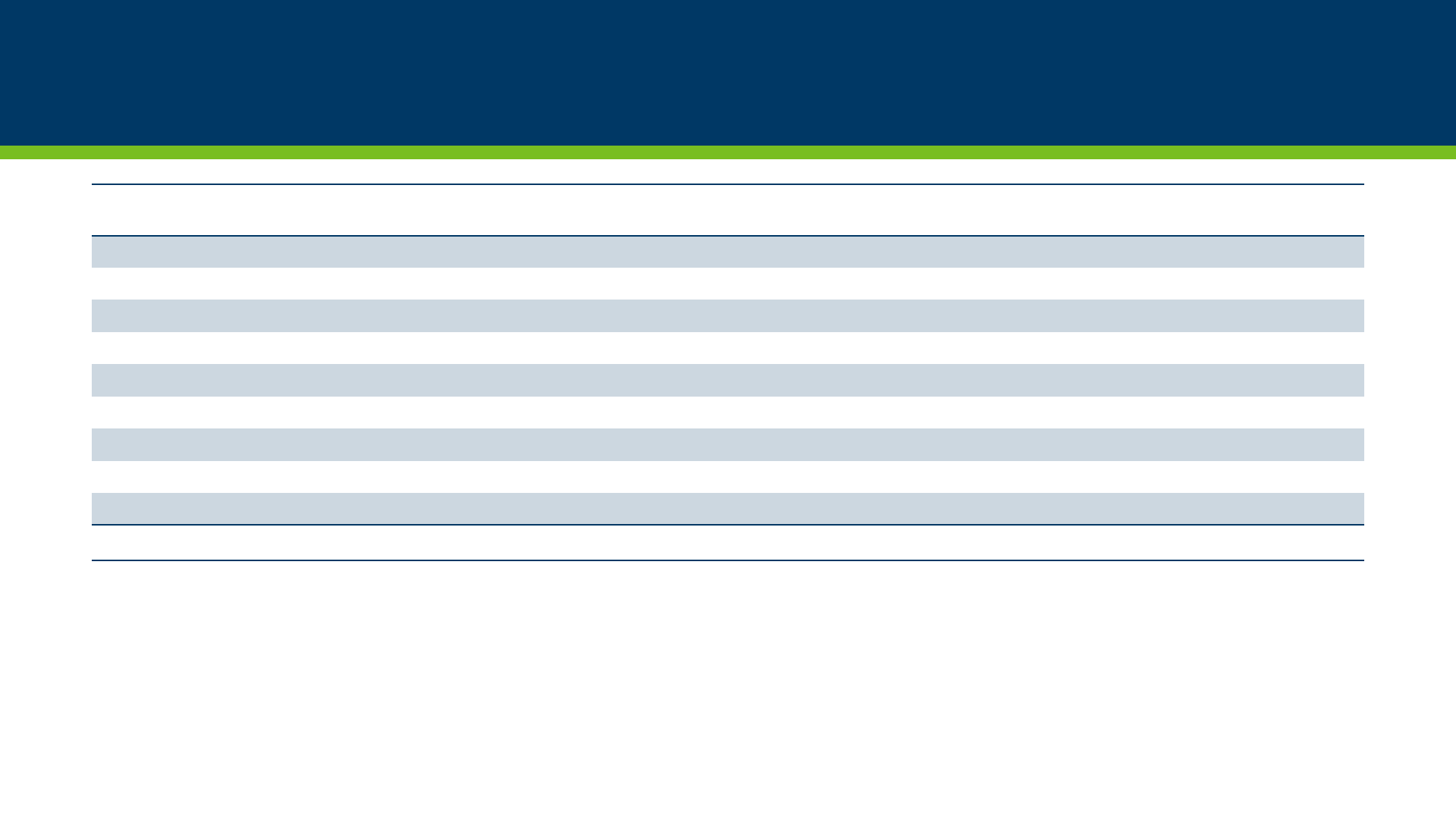
Distribution of HMO Enrollment by Region, 2021
23
Enrollment figures are as of December 31st of each year for Minnesota residents; excludes residents with an unknown county of residence. Data includes all HMO reported enrollment, even for
program types which may not be primary medical coverage (e.g., standalone Part D, Medicare Supplement, and Medicare Select). As such, HMO enrollment may be overstated.
Source: MDH Health Economics Program analysis of Minnesota Supplement #6 HMO report.
Central Twin Cities Northeast Northwest
South
Central Southeast Southwest
West
Central Statewide
Blue Plus
13.6% 5.9% 9.4% 13.5% 7.0% 6.8% 16.3% 14.5% 8.3%
Group Health
0.8% 1.4% 0.3% 0.0% 0.4% 0.0% 0.3% 0.3% 1.0%
HealthPartners, Inc.
4.7% 8.7% 2.4% 0.8% 1.1% 0.2% 0.5% 1.4% 5.8%
Hennepin Health
0.0% 1.1% 0.0% 0.0% 0.0% 0.0% 0.0% 0.0% 0.6%
Medica Health Plans
1.1% 1.5% 0.4% 0.8% 0.5% 0.5% 0.7% 0.9% 1.2%
Quartz
0.0% 0.0% 0.0% 0.0% 0.0% 0.9% 0.0% 0.0% 0.1%
Sanford
0.0% 0.0% 0.0% 0.3% 0.0% 0.0% 0.4% 0.3% 0.0%
UCare
6.5% 12.3% 10.7% 1.9% 7.3% 10.8% 7.2% 2.3% 10.1%
UnitedHealthcare of Illinois
0.0% 0.0% 0.0% 0.0% 0.0% 0.0% 0.0% 0.0% 0.0%
All HMOs
26.8% 31.1% 23.2% 17.2% 16.4% 19.3% 25.4% 19.9% 27.1%
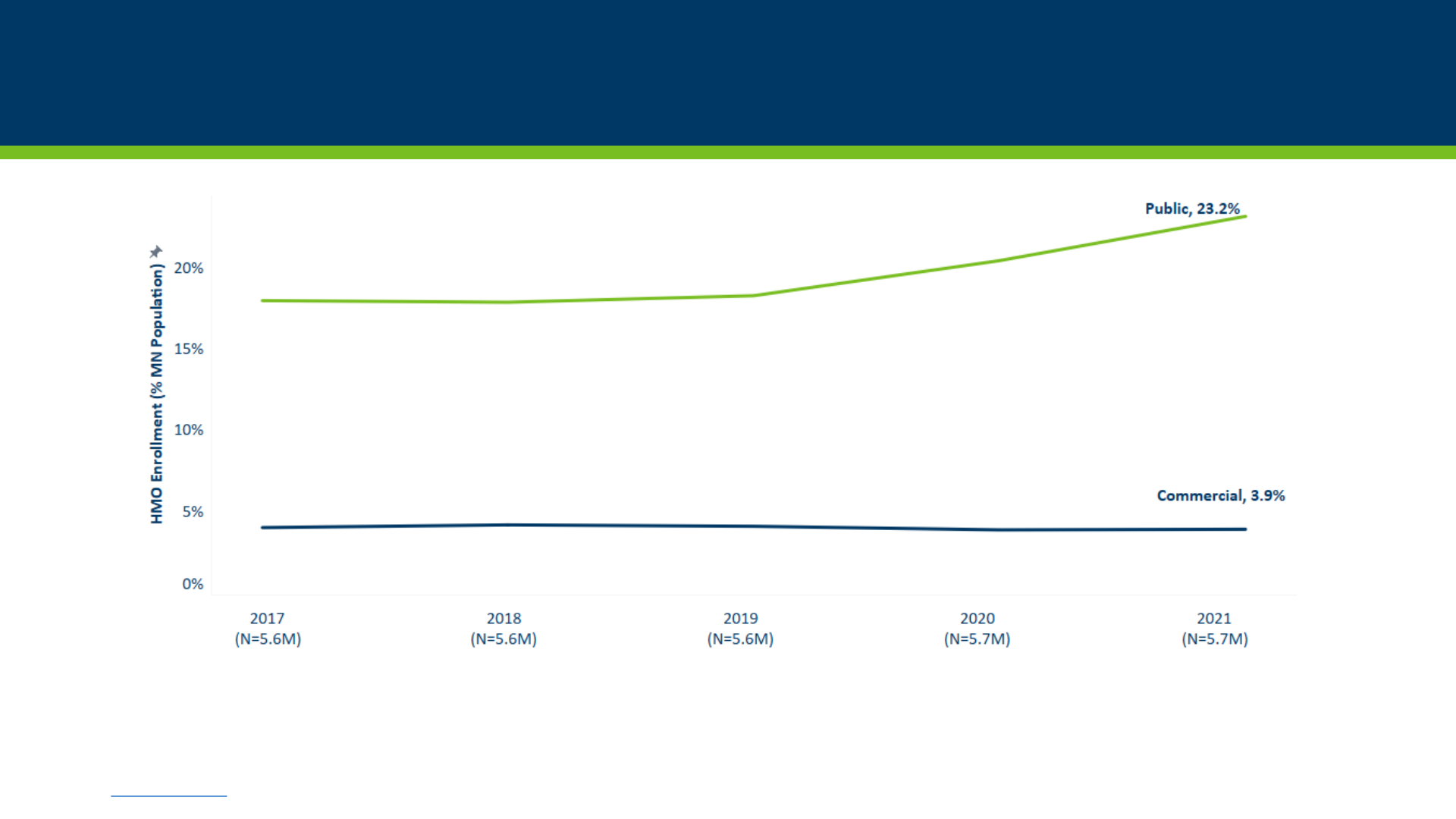
Minnesota HMO Market Penetration
24
Enrollment figures are as of December 31st of each year; excludes residents with an unknown county of residence. Medica no longer accepted enrollment for Medical Assistance/MinnesotaCare
Families and Children effective May 1, 2017. All Other is excluded from this graph and represents between 0.0% to 3.1% each year.
Source: MDH Health Economics Program analysis of MDH Health Economics Program analysis of Minnesota Supplement #6 HMO report; U.S. Census Bureau, Annual Estimates of the Resident
Population for Counties in Minnesota: April 1, 2020 to July 1, 2021, (CO-EST2021-POP-27).
Summary of Graph
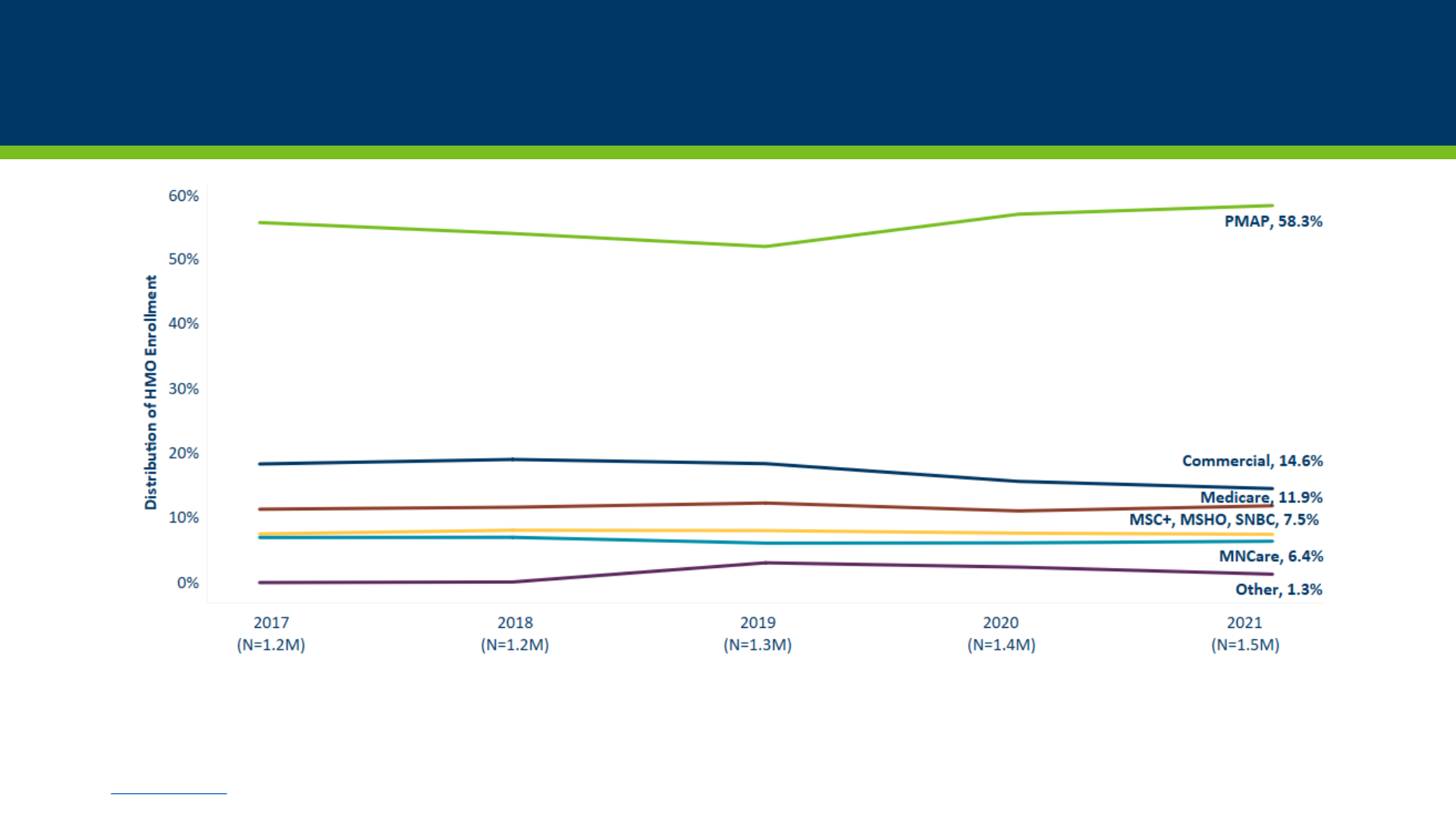
Distribution of Minnesota HMO Enrollment
by Product Line
25
Enrollment is based on total member months. Minnesota products only. MSC+ data prior to 2017 was not consistently broken out by health plan companies and is included in the MSC+ category, as
able. Key terms are included on slide 4. “All Other” enrollment includes all HMO reported enrollment, even for program types which may not be primary medical coverage (e.g., standalone Part D,
Medicare Supplement, and Medicare Select). As such, enrollment may not be unique between product lines.
Source: MDH Health Economics Program analysis of Minnesota Supplement #6 HMO report.
Summary of Graph
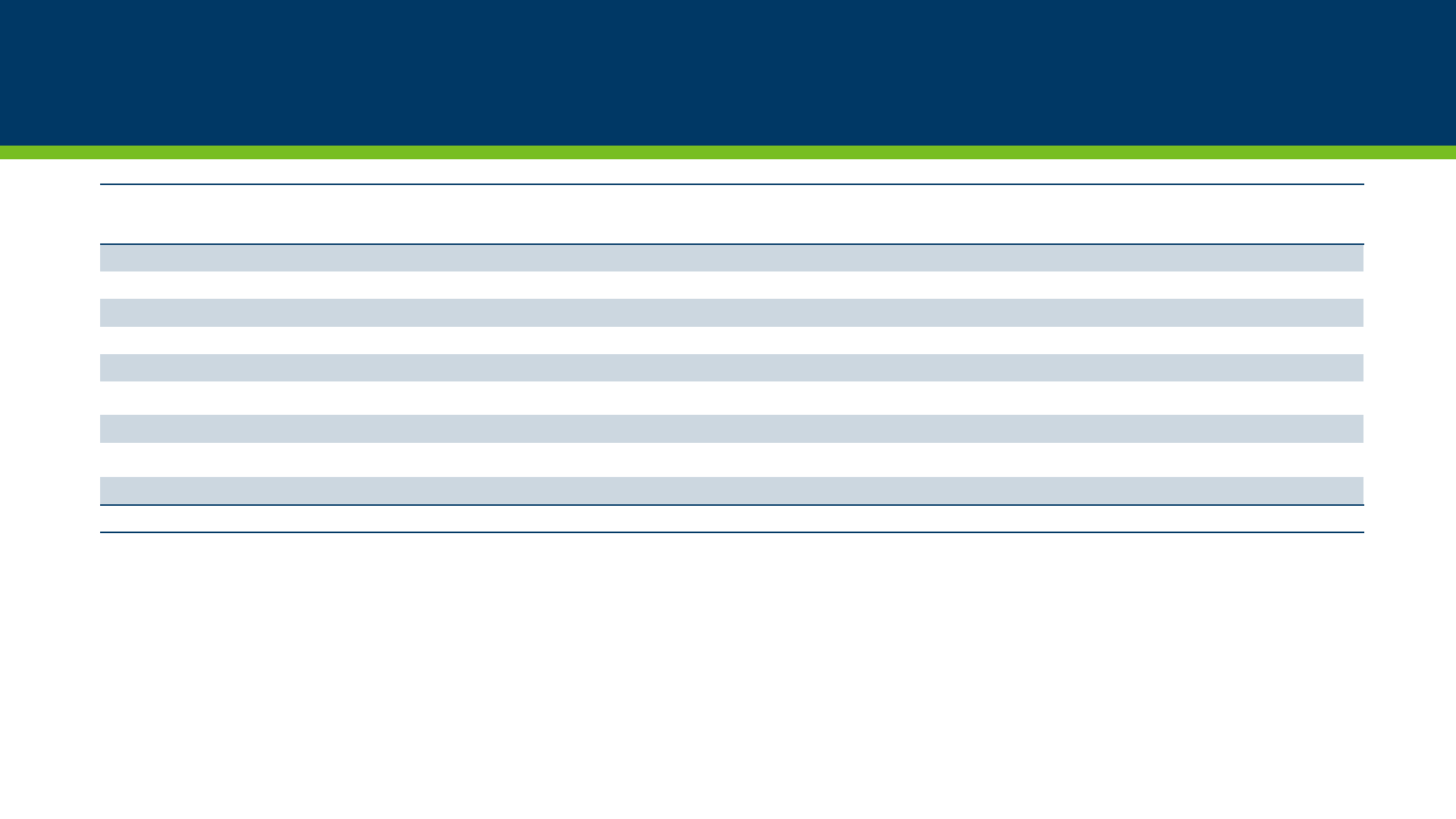
Distribution of Minnesota HMO Enrollment
by Product Line, 2021
26
Enrollment figures are as of December 31st of each year; excludes residents with an unknown county of residence. Minnesota products only. All Other is excluded from this representation. “All
Products” enrollment includes all HMO reported enrollment, even for program types which may not be primary medical coverage (e.g., standalone Part D, Medicare Supplement, and Medicare Select).
As such, HMO “All Products” enrollment may be overstated.
Source: MDH Health Economics Program analysis of Minnesota Supplement #6 HMO report.
Commercial PMAP MNCare Medicare
MSC+, MSHO,
and SNBC All Products
Blue Plus
37,529 389,415 34,281 13,204 474,439
Group Health
53,471 1,424 54,895
HealthPartners, Inc.
79,751 165,408 25,893 35,450 16,127 329,099
Hennepin Health
31,790 2,353 2,197 36,340
Medica Health Plans
<10 27,592 26,497 67,948
Quartz
1,836 2,848 4,684
Sanford
2,134 2,192
UCare
49,649 315,626 36,679 116,711 57,824 576,500
UnitedHealthcare of Illinois
847 847
All HMOs
225,219 902,239 99,206 184,025 115,849 1,546,944
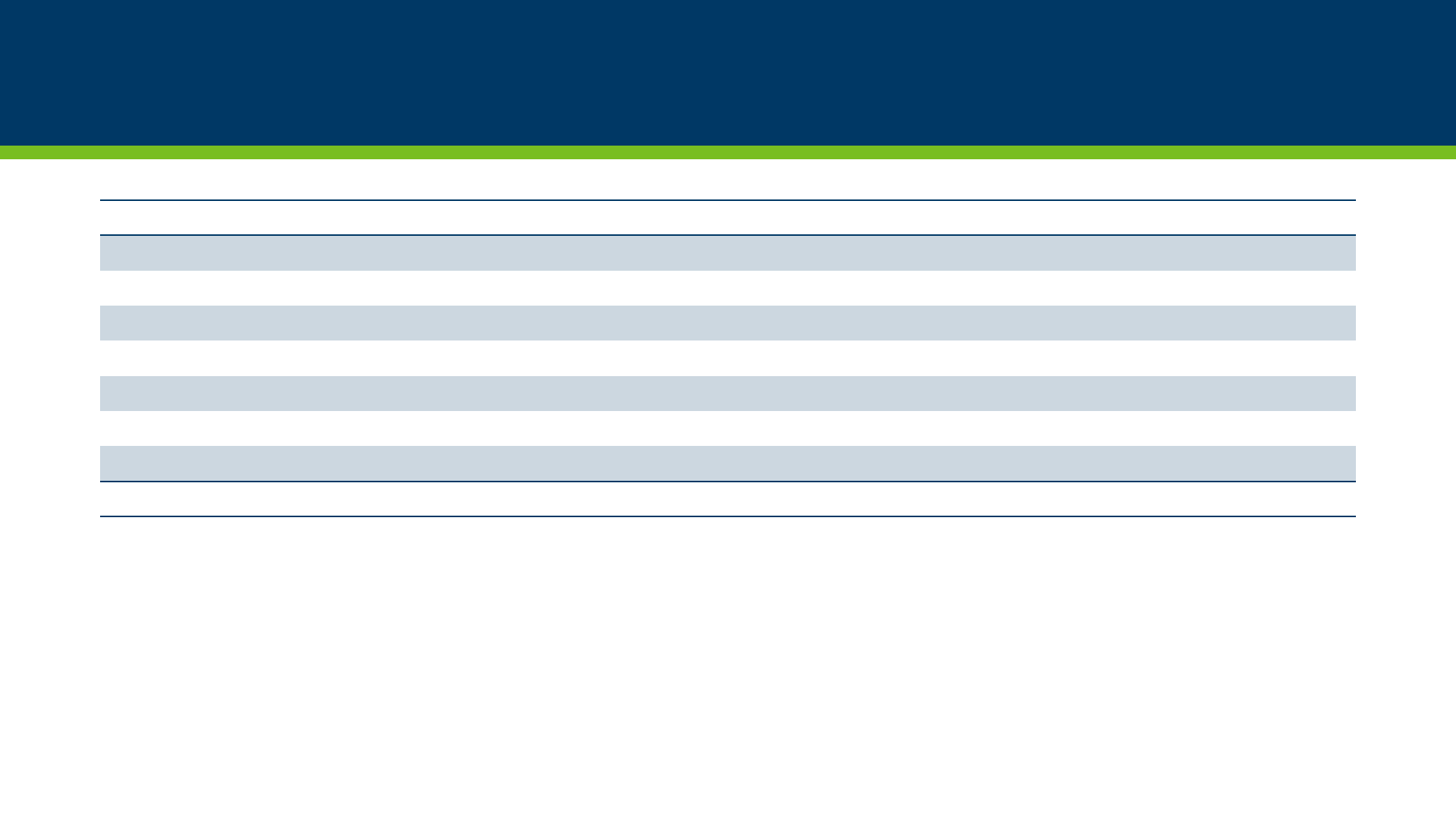
Distribution of Total Minnesota HMO Enrollment by
Product Line and Age, 2021
27
Enrollment figures are as of December 31st of each year. Includes health plan company members that are non-Minnesota residents, unless all enrollment across all product lines is “out of state”. “Total
HMO Enrollment” enrollment includes all HMO reported enrollment, even for program types which may not be primary medical coverage (e.g., standalone Part D, Medicare Supplement, and Medicare
Select). As such, “Total HMO Enrollment” enrollment may be overstated.
Source: MDH Health Economics Program analysis of Minnesota Supplement #6 HMO report.
<18 18-34 35-49 50-64 65+ Total
Commercial
16.2% 22.3% 22.7% 36.6% 2.1%
100.0%
Public Programs
32.8% 22.3% 14.6% 11.4% 18.9%
100.0%
PMAP
47.3% 26.9% 15.8% 10.0% 0.0%
100.0%
MNCare
1.3% 34.5% 31.2% 27.6% 5.4%
100.0%
MSC+, MSHO, and SNBC
0.0% 12.6% 13.6% 23.6% 50.2%
100.0%
Medicare
0.0% 0.0% 0.3% 2.3% 97.4%
100.0%
All Other
0.0% 0.0% 0.3% 2.5% 97.1%
100.0%
Total HMO Enrollment
29.8% 22.0% 15.6% 15.1% 17.6%
100.0%

Additional Information from the Health Economics Program
Available Online
• Health Economics Program Home Page
(https://www.health.state.mn.us/healtheconomics)
• Publications (https://heppublications.web.health.state.mn.us/)
• Health Care Market Statistics (Chartbook Updates)
(https://www.health.state.mn.us/data/economics/chartbook/index.html)
A summary of the charts and graphs contained within is provided at Chartbook Summaries – Section 7
(https://www.health.state.mn.us/data/economics/chartbook/summaries/section7summaries.html)
. Direct links are listed on each page. Please
contact the Health Economics Program at 651-201-4520 or health.[email protected]
if additional assistance is needed for accessing this
information.
28
